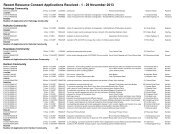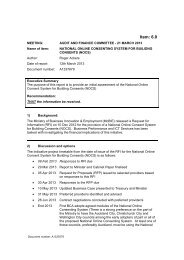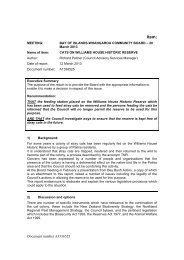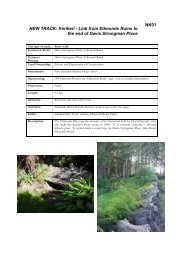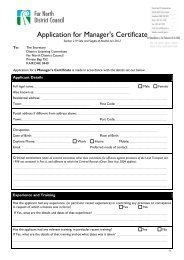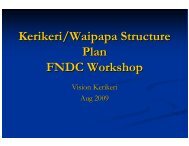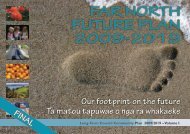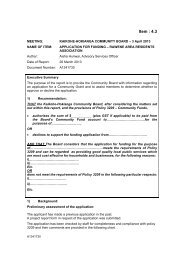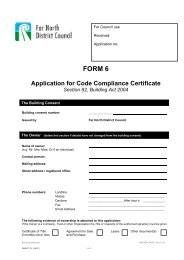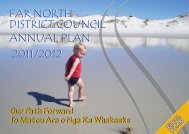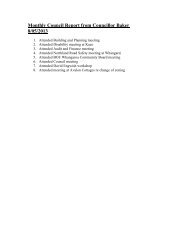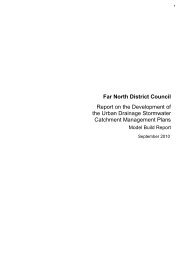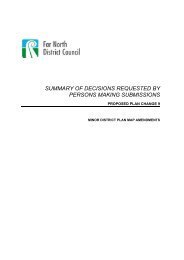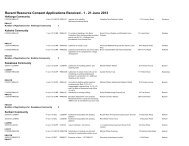Far North District Council Road Improvement Strategy
Far North District Council Road Improvement Strategy
Far North District Council Road Improvement Strategy
Create successful ePaper yourself
Turn your PDF publications into a flip-book with our unique Google optimized e-Paper software.
<strong>Far</strong> <strong>North</strong> <strong>District</strong> <strong>Council</strong><strong>Road</strong> <strong>Improvement</strong> <strong>Strategy</strong>ReportJuly 2005
Contents1. Introduction 41.1 <strong>Road</strong> <strong>Improvement</strong> <strong>Strategy</strong> Objectives 41.2 Development of the <strong>Strategy</strong> and Base Line Report 51.3 Legislative Requirements 51.4 Report Structure 62. National and Regional Legislation and Policy 72.1 Local Government Act 2002 72.2 Land Transport Management Act 2003 72.3 Resource Management Act 1991 82.4 New Zealand Transport <strong>Strategy</strong> 82.5 <strong>Road</strong> Safety <strong>Strategy</strong> 2010 82.6 <strong>North</strong>land Regional Land Transport <strong>Strategy</strong> 2003 -2008 92.7 <strong>North</strong>land Integrated Transport Study 2002 92.8 <strong>North</strong>land Regional Transport Plan 103. <strong>Far</strong> <strong>North</strong> <strong>District</strong> Plans and Policy Documents 123.1 <strong>Far</strong> <strong>North</strong> <strong>District</strong> Draft Long Term <strong>Council</strong> Community PlanJuly 2004 - June 2014 123.2 <strong>Far</strong> <strong>North</strong> <strong>District</strong> Land Transport Programme 123.3 <strong>Road</strong>ing Asset Management Plan 133.4 <strong>Far</strong> <strong>North</strong> <strong>District</strong> <strong>Council</strong> Safety Management System 133.5 Growth Management <strong>Strategy</strong> Project 133.6 Existing <strong>Road</strong>ing Projects 134. Overview of the <strong>Far</strong> <strong>North</strong> 154.1 The Place 154.2 The People 184.3 The Economy 205. The Existing <strong>Road</strong> Network 225.1 State Highways 225.2 Local <strong>Road</strong>s 225.3 Use of the <strong>Road</strong> Network 235.4 Integration with Alternative Modes of Transport 255.5 Funding of the <strong>Road</strong> Network 27<strong>Road</strong> <strong>Improvement</strong> <strong>Strategy</strong>ii
6. Potential Future Growth Areas 296.1 Forestry 296.2 Agriculture 316.3 Tourism 316.4 Aquaculture 336.5 Horticulture 346.6 Residential Development 356.7 Population Change 356.8 Future Demands on the <strong>Road</strong> Network 367. Key Issues for the <strong>Road</strong> Network 387.1 Unsealed <strong>Road</strong>s 387.2 <strong>Road</strong> Safety 387.3 Provision for Pedestrians and Cyclists 397.4 <strong>Road</strong> User Conflicts 398. Identifying the Strategic <strong>Road</strong> Network 419. Assessment Framework for Potential <strong>Improvement</strong>s 50Table IndexTable 1 Population Projections 18Table 2 <strong>Road</strong> Categorisation 22Table 3 <strong>Far</strong> <strong>North</strong> <strong>District</strong> Growth Areas and <strong>Road</strong>ingInfrastructure Needs 36Table 4 Main Land Uses 37Table 5 The Strategic <strong>Road</strong> Network 42Table 6: Weighting Scale for Assessing Projects 50Table 7 <strong>North</strong>land Regional Transport Plan Projects in the<strong>Far</strong> <strong>North</strong> <strong>District</strong> 62AppendicesA ReferencesB Key StakeholdersC Key Objectives of the <strong>North</strong>land Regional Land Transport <strong>Strategy</strong>D Regional Development Fund ProjectsE <strong>Far</strong> <strong>North</strong> <strong>District</strong> Land UseF Strategic <strong>Road</strong> Network<strong>Road</strong> <strong>Improvement</strong> <strong>Strategy</strong>iii
1. IntroductionThe <strong>Far</strong> <strong>North</strong> <strong>District</strong> <strong>Council</strong> (FNDC) has undertaken to develop a <strong>Road</strong><strong>Improvement</strong> <strong>Strategy</strong> (RIS) that will provide a guiding framework for transportdecisions within the <strong>Far</strong> <strong>North</strong> for the next 15 – 20 years. It is intended that the RIS willbe used to develop <strong>Council</strong>’s <strong>Road</strong>ing Capital Works Programme and be reviewed andupdated each year with a major review every five years.This Baseline Data and <strong>District</strong> Overview Report (Baseline Report) is the first stage inthe development of the RIS. It will provide the general background that is needed toidentify the key existing and future demand transport issues facing the <strong>Far</strong> <strong>North</strong><strong>District</strong>. The development of the RIS is to be based on fundamental links madebetween the strategy, land use development, economic development plans, andregional and national transport policies and legislation. This Baseline Report identifiesthese links. It provides a review of relevant policy and strategies at a National,Regional and <strong>District</strong> level and identifies areas of present and future economic andsocial importance throughout the <strong>District</strong>. It will outline a strategic roading network thatwill feed into the regional network developed through the <strong>North</strong>land IntegratedTransport <strong>Strategy</strong>.1.1 <strong>Road</strong> <strong>Improvement</strong> <strong>Strategy</strong> ObjectivesThe objectives of developing a RIS will be to:Identify a strategic transport network to provide for the future needs of the <strong>District</strong>Take account of the transport economics and the economic developmentopportunities of the <strong>District</strong>Provide for future growthIdentify implementation mechanismsAchieve stakeholder acceptanceRecognise the diversity of the region in terms of demographics, land use andsettlement patterns and topographyIdentify and evaluate social, cultural, economic and environmental issuesassociated with achieving the identified strategic networkDevelop an assessment framework to evaluate potential projects against in orderto ensure the integrity of the strategic network development is maintainedIdentify and provide future policy and funding information requirements in order toimplement the strategyDevelop a five year implementation plan with a list of capital works projects,including estimated costs.51/19027/39/RIS July 2005.doc<strong>Road</strong> <strong>Improvement</strong> <strong>Strategy</strong>4
1.2 Development of the <strong>Strategy</strong> and Base Line ReportThis Baseline Report will be used to assist in the development of the RIS, which willoccur in the following five stages:Stage 1Data Collection and Research – during this stage existing and future demands will beidentified as well as stakeholder issues. Consultation with stakeholders will provideinput into the Baseline report.Stage 2Defining Objectives for the network, or the ‘strategic direction’ for the RIS.Stages 3Developing an Assessment Framework for evaluating proposed projects against toensure they are meeting the strategic transport objectives of the <strong>District</strong>.Stage 4Development of a draft RIS that will be approved by <strong>Council</strong> and released for publicconsultation.Stage 5Public consultation period, including submissions, hearings & decisions culminatingwith <strong>Council</strong>’s adoption of the RIS.The Base Line Report has been developed out of stage one; the data collection andresearch stage. It has included comprehensive consultation with identifiedstakeholders listed in Appendix B and a review of relevant policy and research. TheBase Line Report will be used as a consultation tool and distributed widely to identifiedstakeholders for their comment and feedback on the important transport issues facingthe <strong>District</strong>. The Baseline report presents a picture of the <strong>District</strong> and its people.1.3 Legislative RequirementsThe development of a <strong>Road</strong> <strong>Improvement</strong> <strong>Strategy</strong> for the <strong>Far</strong> <strong>North</strong> <strong>District</strong> is not amanatory requirement under the Land Transport Act 1998 or Local Government Act2002. Through its development the <strong>Council</strong> is taking a proactive approach to transportdecision-making within the <strong>District</strong>.<strong>Road</strong>ing and transportation provision are ‘significant’ issues within the <strong>Far</strong> <strong>North</strong> andtherefore the use of special consultative procedures for consulting land transport usersand providers, affected communities, and public and consultation with Maori areconsidered appropriate. The consultation procedures defined in the Local GovernmentAct 2002 are being followed in the development of the RIS.The Land Transport Act 1998 requires that a regional land transport strategy must notbe inconsistent with regional policy statements, or any plan, or any national landtransport strategy. Following this requirement the <strong>Far</strong> <strong>North</strong> RIS will be consistent withthe Regional Land Transport <strong>Strategy</strong> for <strong>North</strong>land.51/19027/39/RIS July 2005.doc<strong>Road</strong> <strong>Improvement</strong> <strong>Strategy</strong>5
1.4 Report StructureFollowing this introduction, Section 2 provides an outline of National and Regionallegislation and policy that is relevant to the development of a <strong>Far</strong> <strong>North</strong> <strong>Road</strong><strong>Improvement</strong> <strong>Strategy</strong>.Section 3 of the report sets out the relevant <strong>District</strong> plans and policy documentsSection 4 gives an overview of the <strong>Far</strong> <strong>North</strong> <strong>District</strong> in terms of its natural andphysical resources, demographics, and the main industries that are important for thedistricts economy.Section 5 overviews the key features of the <strong>Far</strong> <strong>North</strong> land transport system in termsof road, rail, coastal and air.Section 6 includes predicted future trends for land transport and development in the<strong>Far</strong> <strong>North</strong>.Section 7 overviews the key issues for the <strong>Road</strong> Network.Section 8 provides a conclusion to the report and identifies the Strategic <strong>Road</strong>Network.Section 9 presents the Assessment Framework.51/19027/39/RIS July 2005.doc<strong>Road</strong> <strong>Improvement</strong> <strong>Strategy</strong>6
2. National and Regional Legislation and PolicyThere are a number of legislative and statutory planning documents at the Nationaland Regional level that support the development and implementation of a <strong>Road</strong><strong>Improvement</strong> <strong>Strategy</strong> (RIS). An outline of these follows, showing their context and asummary of some relevant information which they contain.2.1 Local Government Act 2002The Local Government Act 2002 (LGA) is based on sustainable, effective, responsible,responsive and accountable local government being fundamental to achieving thelong-term well-being of communities. The LGA outlines the responsibilities of localauthorities and the decision making process for activities undertaken on behalf of theircommunity, primarily through the requirement to adopt a Long Term <strong>Council</strong>Community Plan (LTCCP). <strong>Council</strong>s are encouraged by the LGA to identify overalllong-term priorities and to plan for the future. Although it is not given as a legislativerequirement, this approach supports the development of a strategy that identifies andprioritises roading projects for future development.The LGA also recognises that partnerships are required between district and regionalgovernments, local organisations, central government agencies and the community. Itrequires that <strong>Council</strong>’s consult and seek participation of the communities on decisionsbeing made. The development of the <strong>Road</strong> <strong>Improvement</strong> <strong>Strategy</strong> is consistent withthis approach. It follows, as a guide, the consultation requirements detailed in the LGAfor the development of the LTCCP and works to complement the <strong>North</strong>land RegionalTransport <strong>Strategy</strong>.2.2 Land Transport Management Act 2003The purpose of the Land Transport Management Act 2003 (LTMA) is to:Provide a integrated approach to land transport funding and managementImprove social and environmental responsibility in funding, planning andmanagement of land transportImprove long term planning and investment in land transportEnsure land transport funding is cost effectiveImprove flexibility of funding including enabling land transport infrastructure to bebuilt on a tolled or public/private partnership basis or combination of these.The LTMA also requires the <strong>Council</strong> to consult with a wide range of parties whendeveloping the annual land transport programme and requires that the programmeis consistent with the RLTS.51/19027/39/RIS July 2005.doc<strong>Road</strong> <strong>Improvement</strong> <strong>Strategy</strong>7
Temporary Traffic Management Plans in place at roadworks sites and regularlyaudited.2.6 <strong>North</strong>land Regional Land Transport <strong>Strategy</strong> 2003 -2008The Regional Land Transport <strong>Strategy</strong> for <strong>North</strong>land 2003-2008 (RLTS) developed bythe <strong>North</strong>land Regional <strong>Council</strong> sets out regional priorities for a wide variety of mainlyland-based transport options over the next five years. Air and sea transport are notcovered in detail but their importance is noted.<strong>Far</strong> <strong>North</strong> <strong>District</strong> <strong>Council</strong> were consulted during the preparation of the RLTS and haverepresentation of two members on the <strong>North</strong>ern Regional Land Transport Committeewho oversaw the preparation of the <strong>Strategy</strong>.This <strong>Strategy</strong> also encompasses the findings of the <strong>North</strong>land Integrated TransportStudy 2002, which includes recommendations for development of a transport networkto meet the foreseeable social and economic development needs of the region.Included in the strategy are project priorities, road safety, the views of affectedcommunities, the need to consider alternatives to roading eg rail and barging and theneed to minimise adverse effects on the environment.The FNDC are required to implement the <strong>Strategy</strong> through their district land transportprogramme. In order to do so the RIS must be consistent with the objectives of thestrategy. A full list of the key objectives of the RLTS is included in Appendix C.2.7 <strong>North</strong>land Integrated Transport Study 2002The purpose of the <strong>North</strong>land Integrated Transport Study was to develop a strategy toaddress the immediate and future transport needs of <strong>North</strong>land for all modes oftransport. As outlined above the findings of the study were incorporated into the RLTS.The Study covers a 10 year period from 2002 to 2012 and recommends a regionalintegrated transport network including:That the port at Marsden Point is the sole log and wood products export port for<strong>North</strong>landThat whenever possible forestry traffic is separated from local and tourist trafficThat the Twin Coast Discovery Route be maintained as the primary tourist route in<strong>North</strong>landThat a central route comprising Mangakahia <strong>Road</strong> and Otaika Valley <strong>Road</strong>become the heavy traffic route for traffic to and from Marsden Point to north ofWhangarei and KaikoheThat a barging operation between Kaimaumau and Marsden Point be investigatedRecognition that the roading network needs improvement to meet the increase involumes of logs and wood productsRecognition that the port of Marsden Point will become the primary port servicingthe <strong>North</strong>land region and beyond51/19027/39/RIS July 2005.doc<strong>Road</strong> <strong>Improvement</strong> <strong>Strategy</strong>9
That the existing rail network in <strong>North</strong>land be retained due to it maintaining linearcontinuity and its strategic importance to the national networkThat air transportation is a component of the overall transportation network but itsimpact on the physical road infrastructure is minimalThat the bridging of the Hokianga Harbour is included in the Regional IntegratedTransportation Network and completed by 2005; andThat the western route to Kaitaia via Paponga <strong>Road</strong> and Kaitaia Awaroa <strong>Road</strong> isprogressively upgraded to meet the impact of logging as it arises.The anticipated benefits of the network include: A reduction in the peak daily flows of forestry traffic from 2011Significant savings in road maintenance costs and a reduction in road constructioncosts from the lower number of heavy vehicles on the road networkA significant reduction in travel distance and times for traffic to and from the <strong>North</strong>Hokianga area wanting to travel east and southA separation of heavy and tourist traffic by designating heavy traffic routes withappropriate signageImproved road alignments and gradings increasing road safety, andRegional and national benefitsThe total funding required for the proposed integrated transportation network, includingroads, rail and barging, is $500 million over the next 20 years. In 2002, therequirement for roading in the <strong>Far</strong> <strong>North</strong> between 2002-2012 was estimated as being$96.3 million.2.8 <strong>North</strong>land Regional Transport PlanThe <strong>North</strong>land Regional Transport Plan is developed and reviewed annually by the<strong>North</strong>land Regional <strong>Council</strong>. It is the key mechanism for achieving the objectives of the<strong>North</strong>land Regional Land Transport <strong>Strategy</strong> and contains a prioritised list of projectseligible for regional development funding from Land Transport New Zealand. The planhas no statutory status but is a requirement to receive regional development funding.Indicative <strong>North</strong>land Regional Transport Plans 2004-2005 and 2005-2006 includeprojects within the following roads in the <strong>Far</strong> <strong>North</strong> <strong>District</strong>:West Coast <strong>Road</strong>Kohukohu <strong>Road</strong>Mangakahia <strong>Road</strong>Rangiahua <strong>Road</strong>Mangamuka <strong>Road</strong>Purerua <strong>Road</strong>Omahuta <strong>Road</strong>51/19027/39/RIS July 2005.doc<strong>Road</strong> <strong>Improvement</strong> <strong>Strategy</strong>10
Taheke <strong>Road</strong>The available funding is less than the cost of the proposed work so it is likely that onlysome of these projects will receive funding in the year requested.51/19027/39/RIS July 2005.doc<strong>Road</strong> <strong>Improvement</strong> <strong>Strategy</strong>11
3. <strong>Far</strong> <strong>North</strong> <strong>District</strong> Plans and Policy DocumentsThe previous section has detailed how the development of the <strong>Road</strong> <strong>Improvement</strong><strong>Strategy</strong> (RIS) is consistent with both national and regional policy and plans. The RISalso fits within a framework of <strong>Far</strong> <strong>North</strong> <strong>District</strong> <strong>Council</strong> plans and policies. Thefollowing section outlines the relevant <strong>District</strong> planning documents and outlines howthe RIS is consistent with these documents.3.1 <strong>Far</strong> <strong>North</strong> <strong>District</strong> Draft Long Term <strong>Council</strong> Community PlanJuly 2004 - June 2014The <strong>Far</strong> <strong>North</strong> <strong>District</strong> Draft Long Term <strong>Council</strong> Community Plan (LTCCP) wasdeveloped in 2004 to meet the requirements of the Local Government Act (2002). TheDraft LTCCP sets out the <strong>Council</strong>’s priorities over the medium to longer term. Itexplains how the <strong>Council</strong> intends to contribute to community well being over the life ofthe plan. It provides a basis for decision-making and accountability and an opportunityfor public participation in the decision making process. The purpose of the DraftLTCCP is to articulate and align <strong>Council</strong> activities with what the community needs andcan afford.<strong>Road</strong>ing is specifically addressed in the Draft LTCCP as a key issue for <strong>Council</strong> toaddress and the development of the RIS is outlined as a method for the managementof the <strong>District</strong>s <strong>Road</strong> network as follows:<strong>Council</strong> will develop a 10 year strategy for roading that focuses first andforemost on maintaining and renewing existing assets and priorities strategiccapital works based on:– The availability of subsidy– <strong>Improvement</strong>s to key arterial routes– Routes of strategic importance(LTCCP, 2004 p. 7).The intention of the RIS, as outlined in the LTCCP, is to consolidate and improve theexisting network with a commitment to road improvements to develop an improvedstrategic roading network. The objectives of the RIS, as outlined in Section 1.1 of thisreport, reinforce this intention of the LTCCP. The RIS will identify a strategic transportnetwork that provides for the future social and economic needs of the <strong>District</strong>.3.2 <strong>Far</strong> <strong>North</strong> <strong>District</strong> Land Transport ProgrammeUnder the Land Transport Management Act 2003, councils must prepare an annualland transport programme if they wish to have activities included in centralGovernment’s programmes for National Land Transport or Safety Administration.(These programmes form the basis of the any Central Government subsidies for localroad works). As detailed in the LTCCP it is the intention that the <strong>Far</strong> <strong>North</strong> <strong>District</strong><strong>Council</strong> Land Transport Programme will be developed in conjunction with the RIS.51/19027/39/RIS July 2005.doc<strong>Road</strong> <strong>Improvement</strong> <strong>Strategy</strong>12
The FNDC Land Transport Programme will prioritise land transport improvementinitiatives and detail how each of these projects contribute to the purpose of the LandTransport Management Act. The RIS will provide a framework for the prioritisation ofroading projects to be incorporated in the Land Transport Programme.3.3 <strong>Road</strong>ing Asset Management PlanIn addition to the Land Transport Plan and the RIS, <strong>Council</strong> is developing a <strong>Road</strong>ingAsset Management Plan. The <strong>Road</strong>ing Asset Management Plan will provide a longtermindication of sustainable management of the roading asset and detail workprogrammes incorporating levels of service, risk, growth and demand, maintenance,renewal and new works plans, processes, and practices, financial analysis.3.4 <strong>Far</strong> <strong>North</strong> <strong>District</strong> <strong>Council</strong> Safety Management SystemA Safety Management System is currently being developed for the <strong>Far</strong> <strong>North</strong> <strong>District</strong>,which has implications for the both the design of road improvements and theidentification of those roads that are below safety standards. The safety managementsystem for roads will be based on the recommendations of the New Zealand <strong>Road</strong>Safety <strong>Strategy</strong> as outlined in section 2.5 of this report.“The system approach seeks to ensure that road controlling authorities useconsistent standards and policies. Having systems in place and a means ofauditing them will lead to a more consistent and safer road network.” (Source:<strong>North</strong>land Regional <strong>Road</strong> Safety Plan).3.5 Growth Management <strong>Strategy</strong> ProjectThe <strong>Far</strong> <strong>North</strong> <strong>District</strong> <strong>Council</strong> has commenced a Growth Management <strong>Strategy</strong>Project which aims to gain an improved understanding of the growth issues that facethe <strong>District</strong>. It is anticipated that the strategy will feed into the Long Term <strong>Council</strong>Community Plan. A Growth Forecasts report for the period between 2001-2021 hasbeen prepared and used to inform this baseline report.3.6 Existing <strong>Road</strong>ing ProjectsThe following projects have at this stage been proposed for the <strong>Far</strong> <strong>North</strong> <strong>District</strong>:Hokianga Bridging – viability of road and bridge links across the HokiangaHarbour. (RLTS <strong>North</strong>land P 33)Kerkeri Heritage Bypass – detailed design and construction is currently underway.Special roading initiatives - for example, forestry roading. Highest priority forestryroutes are currently upgraded via the Regional Development Programme at 100%subsidy from Land Transport. <strong>Council</strong> funds some upgrades of lower priority roadsthat provide forestry and community benefit through its annual roading programme.51/19027/39/RIS July 2005.doc<strong>Road</strong> <strong>Improvement</strong> <strong>Strategy</strong>13
Tourist route upgrades. – Indirect benefits for the <strong>District</strong> resulting from touristroute upgrades will be assessed. Where there is a high degree of benefits <strong>Council</strong>will consider carrying out improvements or new works.Strategic programme of roading improvement priorities in the Bay of Islands andKaikohe areas.First Response Works contingency fund to deal with emergency works.51/19027/39/RIS July 2005.doc<strong>Road</strong> <strong>Improvement</strong> <strong>Strategy</strong>14
4. Overview of the <strong>Far</strong> <strong>North</strong>In accordance with the objectives of the LTCCP, the <strong>Road</strong> <strong>Improvement</strong> <strong>Strategy</strong> is toidentify areas of the existing road network for improvement where there is ademonstrated need (LTCCP, 2004 p.8). In order to do so a review of the <strong>District</strong> isrequired to establish the location and type of activities, which are dependant on theexisting road network. This section provides an overview of the <strong>District</strong> in terms of itsresources, population and industry. The information contained in this section has beensought from a review of relevant reports, policies, statistical information 1 and interviewswith identified stakeholders.4.1 The PlaceThe <strong>Far</strong> <strong>North</strong> <strong>District</strong> is the northernmost district in New Zealand with a land area of6,822 square kilometres, making it the second largest district council in terms of landarea. It has 1,756 kilometres of coastline, on both the east and west coasts, andfeatures eight major harbour systems.Figure 1:Locality Map1The statistical data available specifically for the <strong>Far</strong> <strong>North</strong> <strong>District</strong> is limited due to the collection of data byStatistics NZ and other agencies mainly in the context of <strong>North</strong>land. <strong>Far</strong> <strong>North</strong> <strong>District</strong> specific data wouldenable more accurate economic forecasting for the <strong>District</strong>.51/19027/39/RIS July 2005.doc<strong>Road</strong> <strong>Improvement</strong> <strong>Strategy</strong>15
Changing tourism patterns as snowfields and glaciers retreat, visitors will visit otherregions including the <strong>Far</strong> <strong>North</strong>Rising sea levels, predicted to rise between 2 and 35 cm by 2050 which willnegatively impact on productivity of low-lying coastal land and aquatic fresh watersystems due to saline intrusionIncreased impact of wave damage and erosionChanging wind patterns will result in higher rainfall on the west coast and adecrease on the east coastIncreasing possibility of “100 year” flooding eventsThe impact on freshwater and near-shore fisheries has a planning implication forinfrastructure development(Source: FNDC External Environment Overview Review 2000)4.1.4 Heritage ValuesHistorically and archaeologically, the <strong>Far</strong> <strong>North</strong> is richly endowed with a wealth ofassets, many of which are nationally important. eg the Treaty House at Waitangi.There are also a diverse range of European archaeological sites and historic places inthe <strong>District</strong> including, the Stone Store and pear tree at Kerikeri, the King Paddock at TeWaimate and Christ Church Heritage Precinct in Russell. Effects on heritage items(buildings, trees and cultural and archaeological sites) need to be considered inrespect of any improvements to the land transport network. Notable trees, historicsites, archaeological sites, heritage precincts and sites of cultural significance to Maoriare contained in Chapter 11 of the Revised Proposed <strong>District</strong> Plan. <strong>Council</strong> are workingwith tangata whenua to identify sites of cultural significance.4.1.5 Land UseLand use in the <strong>Far</strong> <strong>North</strong> <strong>District</strong> is characterised by the predominance of countrysideand open space. The majority of the <strong>District</strong>’s land area is rural with no single dominanturban area. Urban development is generally spread through the larger towns includingKaitaia, Kaikohe, and Kerikeri with populations between 1,000 - 6,000. Although areasalong the east coast are growing faster than in other areas. Tourism, pastoral farming,forestry and horticulture are the major land uses in the <strong>District</strong>. Section 4.3 of thisreport provides further detail on each of these land uses and the areas of the <strong>District</strong>which are important to the economy.The <strong>Far</strong> <strong>North</strong> <strong>District</strong> <strong>Council</strong> administers 1150 ha of reserve land for esplanade,recreation, local or scenic purposes. <strong>Council</strong> intends to use and develop itsrecreational assets in accordance with local and <strong>District</strong> Recreational Plans. A <strong>District</strong>Recreational Plan is due for completion at the end of 2004. High use recreational areasfor both passive and active recreation include:Waipapa Sports GroundLindvart Park and Central Rugby Ground in Kaikohe51/19027/39/RIS July 2005.doc<strong>Road</strong> <strong>Improvement</strong> <strong>Strategy</strong>17
Centrepark in KaitaiaKerikeri DomainCentenial Park in KaitaiaMemorial Park in KaikoheMaritime Lawn in PaihiaPaihia Village GreenJohnson Park KawakawaThe Strand in Russell4.2 The PeopleAt the 2001 Census, the <strong>Far</strong> <strong>North</strong> <strong>District</strong> ranked 17 th in size of the 74 territorialauthorities in New Zealand, with 1.5% of New Zealand’s population. There is anestimated 7.5 people per square kilometre in the <strong>Far</strong> <strong>North</strong> compared with the NewZealand average of 14.1 people per square kilometre. There is a significantly higherproportion of Maori in the <strong>Far</strong> <strong>North</strong> <strong>District</strong> than the 15% proportion of population forNew Zealand. In the <strong>Far</strong> <strong>North</strong> 44% are Maori and 51% European. Populationprojections for the <strong>Far</strong> <strong>North</strong> <strong>District</strong> out to year 2021 are shown in the table below.Table 1Population ProjectionsTotalPopulationTotal GrowthGrowth fromNatural IncreaseGrowth from NetMigration2001 56,400 2001-2011 7,100 3,100 4,0002011 63,500 2011-2021 6,400 2,400 4,0002021 69,900 - - - -Total - 13,500 5,500 8,000Source: <strong>Far</strong> <strong>North</strong> <strong>District</strong> <strong>Council</strong>, Growth Management <strong>Strategy</strong> Project: Growth Forecasts, December2004, p.12.According to the medium projection series of Statistics NZ, the resident population of<strong>Far</strong> <strong>North</strong> <strong>District</strong> is projected to increase by around 13,500, from 56,400 in 2001 to69,900 in 2021. This is a 23 percent increase and compares with the projectednational increase of 16.1 percent during the same period. In 2001 <strong>Far</strong> <strong>North</strong> <strong>District</strong>represented 1.5 percent of New Zealand’s resident population. In 2021 the <strong>District</strong> isprojected to represent 1.4% of New Zealand’s resident population (Statistics NewZealand Sub National Population Projections, 2001(Base)-2021).4.2.1 HouseholdsThe number of households in the <strong>District</strong> in 2001 was 20,213 with an averagehousehold size of 2.5 people. The latest statistics available for the December 2003quarter show that there have been 432 new dwellings authorised for construction in the51/19027/39/RIS July 2005.doc<strong>Road</strong> <strong>Improvement</strong> <strong>Strategy</strong>18
past year. This represents a rise of 28.6% new dwellings from the previous year andan increase of 14% floor area from the previous year compared with a nationalincrease of 15.5%. It is estimated that from 2001 to 2021 there will an additional 5,400household units in the <strong>District</strong> (<strong>Far</strong> <strong>North</strong> <strong>District</strong> <strong>Council</strong>, Growth Management<strong>Strategy</strong> Project: Growth Forecasts, December 2004).4.2.2 EthnicityAt the 2001 Census, 44.7% of the <strong>District</strong>’s population indicated that they belonged tothe New Zealand Maori ethnic group compared with 14.7% nationally. The <strong>Far</strong> <strong>North</strong><strong>District</strong> has 4.1% of the Maori population of New Zealand. Pacific Island people (2.7%)and Asian people (1.3%) have a smaller representation compared with that of thewhole of New Zealand (at 6.5% and 6.6% respectively).4.2.3 Age StructureThe median age of people in the <strong>Far</strong> <strong>North</strong> is 36.6, compared with 34.8 for all of NewZealand. Twelve and half percent of people (6,825) are aged 65 and over and 26.3%(14,370) is aged under 15 years. The population of the <strong>Far</strong> <strong>North</strong> are rapidly aging.Over the next 25 years the age profile of the <strong>District</strong> will change substantially. Thenumber of school going children will see little growth and continue to reflect the higherpopulation levels. School leavers will increase markedly making the need for localemployment crucial. The most increase though occurs in the group of people over 55years of age and the large portion of the community that will be retired. Depending onthe degree of affluence of this group, issues like pensioner housing, health care,emergency services, recreational needs and public transport will take on new priorities.(Source : FNDC Eternal Environment Overview Review 2001)4.2.4 WorkThe size of the <strong>North</strong>land regional labour force totalled 60,959 during the March 2004quarter. For that quarter the unemployment rate for the region was 4.2% comparedwith the New Zealand unemployment rate of 4.6%. The most popular occupationalgroup in the <strong>Far</strong> <strong>North</strong> <strong>District</strong> is in agriculture and fishery. The main activity in therural areas is grassland/pastoral farming and exotic forestry is a significant andgrowing rural activity. The largest industry in terms of full time equivalents (FTE) inFebruary 2003 was the retail trade, which employed 15.1% of all FTEs in the <strong>District</strong>.The manufacturing and health and community services industries both employed11.5% of total FTEs in the <strong>District</strong>. There has been a significant fall in unemploymentlevels for <strong>North</strong>land where in June 1999 the level was 13.1%, by March 2001 this hadfallen to 7.7% and to 4.2% in March 2004.The national unemployment rate stands at 4.6% for the March 2004 quarter. Theunemployment rate for <strong>North</strong>land stands at just under this rate at 4.2%. (Statistics NZ<strong>Far</strong> <strong>North</strong> <strong>District</strong> Quarterly Review March 2004)51/19027/39/RIS July 2005.doc<strong>Road</strong> <strong>Improvement</strong> <strong>Strategy</strong>19
4.2.5 WealthThe median income for people in the <strong>Far</strong> <strong>North</strong> <strong>District</strong> is $14,100 compared with$18,500 for all New Zealand. (Source: FNDC LTCCP 2004-2014) In December 2003males and females earned an hourly rate of $18.81 and $16.52 respectively,representing an increase of 1.2% for males and an increase of 0.4% for females fromSeptember 2003.4.3 The EconomyMajor revenue earning industries for the <strong>Far</strong> <strong>North</strong> are forestry, agriculture, horticulture,and tourism. In addition there is potential growth in the aquaculture and commercialindustries.4.3.1 ForestryApproximately one sixth of the <strong>District</strong> area is in production forestry making it a keyrevenue earning industry in the <strong>Far</strong> <strong>North</strong>. Forty six percent of the <strong>North</strong>land plantationestate is in the <strong>Far</strong> <strong>North</strong> <strong>District</strong>. Logs are transported to Marsden Point and to millsin Whangarei and towns in the <strong>Far</strong> <strong>North</strong> <strong>District</strong> including the Triboard mill at Kaitaiaand the wood processing facilities at Kerkeri. It is expected that forestry, in particular,will prove to be a growth industry, especially with wood prices rising and totalestimated production increasing sharply over the next 10-15 years. There is generallya north to south movement of logs using the state highways in the <strong>Far</strong> <strong>North</strong>. A smallamount is sent by rail from Otiria to the chipper at Portland.4.3.2 AgricultureThe dairy industry plays a major role in the <strong>North</strong>land Region given the steady growthin returns, dairy cow numbers and processing investment. There has also been anexpansion in alternative forms of farming, including deer.” (Source: <strong>North</strong>landSustainable Economic Development <strong>Strategy</strong>, 2002). The <strong>Far</strong> <strong>North</strong> is a large producerof beef and there has been a 2-3% increase in milk production in the <strong>Far</strong> <strong>North</strong> overthe last few years.The agricultural industries main impact on the transport network is from milk tankermovements that are focused on State Highways 1,10 and 12. In addition, stock truckmovements are focussed on the routes to the Kaikohe saleyards and the Moerewafreezing works but the majority of processing does not occur in the <strong>Far</strong> <strong>North</strong>. Thesemovements vary during the year due to seasonal dairy operations. The highestmovements are in the summer period.4.3.3 HorticultureThe Horticulture industry is a growing industry in the <strong>Far</strong> <strong>North</strong> <strong>District</strong>. At present it iscentred on the export industry in Kerikeri where kiwi fruit, avocados, squash, flowersand citrus are grown. Horticulture is poised to make huge increases in productionbased on newly developed export varieties. (Source <strong>North</strong>land Sustainable EconomicDevelopment <strong>Strategy</strong>, 2002)51/19027/39/RIS July 2005.doc<strong>Road</strong> <strong>Improvement</strong> <strong>Strategy</strong>20
4.3.4 TourismTourism is a key revenue earning industry in the <strong>Far</strong> <strong>North</strong> <strong>District</strong>. It contributes anestimated $230-500 million to the <strong>North</strong>land economy and employs around 10% of theentire <strong>Far</strong> <strong>North</strong> workforce. The concentration of tourism activities are focused on thecoastal areas in the east, most significantly in the Bay of Islands and the DoubtlessBay areas. The Kerikeri Township and 90 Mile Beach are also significant tourist ‘hotspots’ in the <strong>District</strong>.The Twin Coast Development Project (TCDP) has worked towards enhancing thetourism industry in the <strong>District</strong>. It has improved movement of tourists from theWhangarei and Kaipara <strong>District</strong>s to the <strong>Far</strong> <strong>North</strong> and has worked towards distributingtourism receipts more evenly through out the <strong>North</strong>land Region. The majority of touristtraffic however, is still concentrated on State Highways 1 and 10.4.3.5 AquacultureThe fishing and aquaculture sector holds significant potential for the <strong>Far</strong> <strong>North</strong> due tothe existence of natural sites for coastal shellfish farming. Aquaculture, mostly basedin the <strong>Far</strong> <strong>North</strong> <strong>District</strong>, directly employs around 400 people (320 FTE) and earnsmore than an estimated $20 million a year for the <strong>North</strong>land Region.At present commercial aquaculture in <strong>North</strong>land is dominated by Pacific oysterproduction, mostly in the Bay of Islands, Whangaroa, Houhora, and ParengarengaHarbours. There is a relatively small scale but well established mussel farm industry inHouhora Bay. NIWA has established an aquaculture research and developmentcentre near Ruakaka, which has the potential to help bring new aquaculture venturesto the <strong>North</strong>land Region. Most seafood products leave the <strong>District</strong> by road, usually forAuckland where they are often processed or prepared for export. Substantial seafoodprocessing plants are also present in Kaeo and near Kaitaia.4.3.6 Retail and Commercial developmentRetail trade in <strong>Far</strong> <strong>North</strong> is steadily growing largely driven by population growth. Retailtrade was the largest industry in terms of FTEs employing 15.1 % of all the FTE in the<strong>District</strong> at February 2003.51/19027/39/RIS July 2005.doc<strong>Road</strong> <strong>Improvement</strong> <strong>Strategy</strong>21
5. The Existing <strong>Road</strong> Network5.1 State HighwaysTransit New Zealand maintains 490 km of road in the <strong>Far</strong> <strong>North</strong>, being State Highwaysor strategic routes. The <strong>North</strong>land region is serviced by the following state highways:SH1 is located within the eastern section of the region to Kawakawa, then throughthe central section of the region to Kaitaia then along the eastern side of thenorthern region to the top of the <strong>North</strong> Island. The highway passes over theBrynderwyn Hills, south of Whangarei and the Maungataniwha Range north ofKaitaia.The Brynderwyn Hill has a passing lane on the northern flank for southbound trafficand two passing lanes which cover approximately 50% of the length on thesouthern flank. The highway over the Maungataniwha Range is two lanes andcontains steep grades and substandard curves.SH 10 is located along the eastern section of the region from Kaitaia joining SH1near Kawakawa. This route provides access to numerous coastal communitiesand holiday areas. Commercial traffic along the route is light.SH 11 provides the access to the Bay of Islands from SH1 at Kawakawa.SH 12 starts at the Brynderwyn junction with SH1, through Dargaville, then up thewestern side of the region through the Waipoua Forest to the Hokianga Harbourthen eastwards through Kaikohe to join back into SH1 at Ohaeawai.5.2 Local <strong>Road</strong>sThe <strong>Far</strong> <strong>North</strong> <strong>District</strong> <strong>Council</strong> maintains 2,510 kilometres of local roads. The majorlocal arterials are:Kohukohu <strong>Road</strong> and Kaitaia Awaroa <strong>Road</strong> which is part of the Twin CoastDiscovery Route.Mangamuka <strong>Road</strong> which provides a link between SH1 and the Twin CoastDiscovery Route on the southern side of the Mangataniwha Range.Mangakahia <strong>Road</strong> (approximately 33% of its total length) which provides a centralroute for traffic travelling south from Kaikohe that does not pass throughWhangarei.<strong>Far</strong> <strong>North</strong>’s road hierarchy is made up of the following classes of roads, listed in orderof importance in terms of vehicle volumes and strategic importance:Table 2<strong>Road</strong> CategorisationCategory Descriptions Numberof kmPercentage ofkm sealedStrategic <strong>Road</strong>s of strategic importance 36km 44%51/19027/39/RIS July 2005.doc<strong>Road</strong> <strong>Improvement</strong> <strong>Strategy</strong>22
Category Descriptions Numberof kmnationallyPercentage ofkm sealedArterial <strong>Road</strong>s of regional importance 160km 100%Collector <strong>Road</strong>s of local significance 445km 61%LocalAll other roads maintained by<strong>Council</strong>1,869km 14%(Source: FNDC Draft LTCCP 2004-2014)5.3 Use of the <strong>Road</strong> NetworkIt is estimated that the existing relative significance of different modes in terms ofvehicle movements on roads in the <strong>Far</strong> <strong>North</strong> <strong>District</strong> is as follows. These estimatesare expressed as a percentage of total heavy traffic movements in the <strong>Far</strong> <strong>North</strong> on allmajor routes. Forestry 43% General freight 39% Agriculture 4.2% Tourism 4.5% School buses 9.6%(Figures based on data from <strong>North</strong>land Regional <strong>Council</strong> Heavy Traffic Volumes <strong>North</strong>land).5.3.1 Public TransportThe public passenger transport system in the <strong>Far</strong> <strong>North</strong> <strong>District</strong> is made up mainly offerry and bus services. Private operators run nearly all the services on a commercialbasis. There is no Total Mobility Scheme for those with disabilities and special needs.The rail network does not carry passengers, however an enthusiast group hasmaintained a tourist train between Kawakawa and Opua in the past. This is presentlynot operational.FerriesThe following ferry services operate in the <strong>Far</strong> <strong>North</strong>. For the Bay of Islands, apassenger and vehicular service operating between Opua and Okiato Point and apassenger service from Paihia to Russell. In the Hokianga there is a passenger andvehicular service between Rawene and Rangiora. These ferry services are mostlytourist based and do not attract patronage funding.BusesThere are regular bus services to and from the <strong>Far</strong> <strong>North</strong> including:Inter-city Coachlines who provide bus services from Auckland to Kawakawa,Paihia, Kerikeri, Kaikohe and Kaitaia.51/19027/39/RIS July 2005.doc<strong>Road</strong> <strong>Improvement</strong> <strong>Strategy</strong>23
according to location (eg close to schools and hospitals have higher priority than otherareas), traffic density of the area and whether the berm is suitable for pedestrianswithout constructing a formal footpath.There are a number of recreational walking tracks operated by the Department ofConservation the major ones include the Cape Brett Walkway, Cape Reinga CoastalWalkway and the Golden Stairs Track from Hokianga Harbour to Whangape Harbour.Cycling is one of the most sustainable forms of transport providing benefits forpersonal health and the environment. The <strong>North</strong>land Regional Land Transport PolicyFour states “To recognise and provide for safe cyclist mobility and access to cycling”.As an action of this policy it is intended to conduct a cycle/walkway network study for<strong>North</strong>land in the next two to three years.5.4 Integration with Alternative Modes of TransportA key component of the <strong>North</strong>land Regional Land Transport <strong>Strategy</strong> is the integrationof the differing modes of transport. Although focused on roading the RIS will bedeveloped to ensure that it is integrated with and provides connections to alternativemodes of transport.5.4.1 RailThe <strong>Far</strong> <strong>North</strong> <strong>District</strong> is served by the Auckland to Whangarei line with a shunt linebetween Whangarei and Otiria, which operates freight services only. The present railsystem has plenty of future capacity for freight movement.At present there is no rail link to Marsden Point Port. Whangarei <strong>District</strong> <strong>Council</strong> andthe <strong>North</strong>land Regional <strong>Council</strong> have completed an investigation into the feasibility of arail link to the Marsden Point Port. This study shows that the construction of this link isuneconomic at this stage (pers communication Dave Macdonald, Land Transport).Without this link the impact on the <strong>Far</strong> <strong>North</strong> roading network from the transportation byroad of timber and freight will continue to increase.The rail track and infrastructure is returning to Government ownership on 1 July 2004.Future funding of the service may come from companies and local authorities wishingto use the track. It is not proposed to introduce passenger services in the next 15years. Formation of a track <strong>North</strong> to Okaihau is supported by industrial interests andmay become a reality within 10-15 years.5.4.2 CoastalThere is no active barging operation in the <strong>Far</strong> <strong>North</strong> <strong>District</strong>. The majority of CoastalShips use the Marsden Point Port located outside the <strong>Far</strong> <strong>North</strong> <strong>District</strong>, in Whangarei.Opua is used for berthing cruising yachts and receiving passengers from cruise linerswhich anchor off Russell during the summer months.The cruise ship market has developed rapidly in recent years with 24 cruise ship visitsin the 2002/03 season and the Bay of Islands is rated as one of the favourite ports ofcall in New Zealand. Visits typically occur in the high summer season when51/19027/39/RIS July 2005.doc<strong>Road</strong> <strong>Improvement</strong> <strong>Strategy</strong>25
infrastructure is stretched and many attractions are fully booked. Infrastructureimprovements to wharfage and berthing facilities are required to relieve loading andcongestion problems and meet visitors’ expectations.The <strong>Far</strong> <strong>North</strong> <strong>District</strong> has also been successful in capturing customs clearance,refurbishment and maintenance of a significant number of privately owned superyachtsand overseas yachts visiting New Zealand. Currently 90-95% of foreign yachts visitingNew Zealand are clearing customs at Opua. It is important that facility improvementcontinues to develop to maximise the attractiveness of the district to capture theeconomic impacts of these visitors, including vessel refurbishment and provisioning(Source: <strong>North</strong>land Tourism <strong>Strategy</strong> 2003).It is expected that the cruise ship market will develop slowly when the internationalpolitical scene and terrorist activity subsidies. The Australasian cruise routes areexpected to be patronised by passengers who are presently travelling in the UnitedStates, Carribean and Alaska markets. There is an anti terrorism programme in placefor Waitangi which has been approved by American authorities and development hasbeen completed of the Waitangi Wharf and bus turning circle. Cruise liners can clearcustoms in a dedicated customs area of the bay off Opua. (pers comm. MalcolmNicholson, <strong>Far</strong> <strong>North</strong> Holdings Limited)There are a number of parking issues at marine facilities. The most severe site isMangonui Wharf where a wharf development plan is being prepared for a largercarparking facility. Other sites with issues include Mill Bay (severe parking and accessissues), Opua, Kerikeri Inlet and others identified in the <strong>North</strong>land Regional <strong>Council</strong>Coastal Plan. Resolution of these issues may require road widening, land reclamationfor carparking or possible removal of wharf ramps and re-development at an alternativesite with adjacent parking.5.4.3 AirThe main commuter airports in the <strong>Far</strong> <strong>North</strong> are located at Kerikeri and Kaitaia. Thereis no dedicated airfreight service for the <strong>Far</strong> <strong>North</strong>. There are thirty commercial flightsto Kerikeri and Kaitaia airports each week. The average passenger loadings areestimated at 14 passengers per flight. This equates to 5,040 per annum (Source RLTS).<strong>Council</strong> leases the Kaitaia airport from the Crown. Where as the Kerikeri Airport isowned by <strong>Far</strong> <strong>North</strong> Holdings Limited, the <strong>Council</strong> and the Crown in parts. There is asmaller airport located at Kaikohe which is predominantly used for recreational flying.The effect of air transport on the physical transportation network is negligible incomparison to the goods and people moved using the other modes of transport.(Source: <strong>North</strong>land Integrated Transport Study 2002).<strong>Far</strong> <strong>North</strong> Holdings Limited have a 20 year projection structure plan for Kerikeri Airportproduced in 2000. The growth numbers in that plan have already exceeded predictionsin the first four years. It is now predicted that the number of scheduled flights willincrease to be in the range of 10-15 per day over the next 15 years. This summer it isexpected that there will be 6 flights per day. Air New Zealand is currently assessing anumber of 40 seat configuration aircraft as opposed to the present 19 seaters utilised.51/19027/39/RIS July 2005.doc<strong>Road</strong> <strong>Improvement</strong> <strong>Strategy</strong>26
In the future the Kerikeri Airport may operate aircraft of up to 65 seats capacity.Dependent on the 40 seater aircraft selected there may be a need to lengthen therunway. This would necessitate a drop in height of Wairoa <strong>Road</strong>. Designs forincreasing the size of the terminal are also being developed. Should the terminal berelocated then access changes would be required also from Wairoa <strong>Road</strong>.It is not expected that there will be any change to the Kaitaia Airport in the next 10-15year period. There is community will for the airport to be developed into aninternational facility. This would necessitate the lengthening of the current runwaywhich would require some minor road alignment on Quarry <strong>Road</strong>. (pers comm. MalcolmNicholson FNHL).5.5 Funding of the <strong>Road</strong> NetworkFunding of the <strong>Far</strong> <strong>North</strong>’s land transport network is achieved primarily through aseries of land transport programmes. Transit New Zealand (for State Highways),<strong>Council</strong> (for local roading) and the Regional <strong>Council</strong> (for any regional land transportprojects, including passenger transport and rail) prepare land transport programmeseach year. These programmes set out funding requirements for the year and areforwarded to Land Transport New Zealand with a request for funding. Land Transportfunds 100% of some projects under its Regional Development Output Group andsubsidises others depending on local authorities providing funds to match theallocations available from Land Transport. The <strong>Far</strong> <strong>North</strong> <strong>District</strong> will receive 56%financial assistance for local roading maintenance in the 2004/05 financial year and66% for construction of new roads. Subsidy rates are based on the ratio of programmeexpenditure to rateable land value in each district. Transit New Zealand and theWaitangi National Trust projects are funded 100%. The Trust’s roads are specialpurpose roads through the Trust area and these are administered by the <strong>Far</strong> <strong>North</strong><strong>District</strong> <strong>Council</strong>.Another possible funding option for future road upgrading works may be the forestryindustry particularly where the only beneficiary of a road upgrading is the forestowners.“Projects funded by the Regional Development Output Group are for forestry roadingmainly and must:Provide or improve access in such a way that will encourage direct additionalinvestment in a regionSignificantly reduce travel costs for industryMitigate adverse effects on safety, environment and amenity including conflictswith tourist traffic: and or reduce travel costs. “(Source RLTS).Alternatives to roading and barging proposals can also be considered andpromotion of walking and cycling, including development of walking and cyclingstrategies, promotion of walking and cycling activities in a region and infrastructureprojects. (Source RLTS).51/19027/39/RIS July 2005.doc<strong>Road</strong> <strong>Improvement</strong> <strong>Strategy</strong>27
A RIS provides an opportunity to consider the benefits of alternative forms of transportand the cost effectiveness of various options. An example is the cost effectiveness ofroad upgrades to cope with increased demand, versus putting equivalent funding intopublic transport.The implementation methods will be dealt with as part of the <strong>Far</strong> <strong>North</strong> <strong>District</strong><strong>Council</strong>’s funding policy for specific projects and undertaken through <strong>Council</strong>’s AnnualPlan and Long Term <strong>Council</strong> Community Plan processes. Each separate projectrequires a cost/benefit analysis to ensure that the expenditure is financially justified interms of the benefits derived.51/19027/39/RIS July 2005.doc<strong>Road</strong> <strong>Improvement</strong> <strong>Strategy</strong>28
6. Potential Future Growth AreasThe <strong>North</strong>land Regional <strong>Council</strong>’s economic strategy concludes, “the provision ofappropriate <strong>North</strong>land regional infrastructure will underpin the drive for regionaleconomic prosperity” (<strong>North</strong>land Sustainable Economic Development <strong>Strategy</strong>, 2002).<strong>Road</strong>ing infrastructure is essential to supporting economic growth in the <strong>District</strong> andtherefore an objective of the RIS is to develop a road network which provides for futuregrowth in the <strong>Far</strong> <strong>North</strong> <strong>District</strong>.This objective is supported by the <strong>Far</strong> <strong>North</strong> <strong>District</strong> <strong>Council</strong>’s Growth Management<strong>Strategy</strong> Project which aims to forecast growth in the <strong>District</strong> so that it can anticipatethe future infrastructure needs of the <strong>District</strong> and synchronise the development ofinfrastructure necessary to service growth with land use. It is essential therefore thatthe RIS is linked to the findings of the Growth Management <strong>Strategy</strong> and that itanticipates the demands placed on the <strong>District</strong>’s roading resource as a result of thegrowth forecasts.This section identifies potential areas of growth in the <strong>Far</strong> <strong>North</strong> and their potentialeffects and demands on the road network. A land use map included in Appendix Eillustrates these areas of growth.6.1 ForestryThe volume of forestry woodflow in <strong>North</strong>land, including logs and wood products isforecast to increase generally from the present (2002) 1.5 million tonnes per year to 4million tonnes in 2011. (Source: GHD, Integrated Transport <strong>Strategy</strong>). Longer-termforecasts predict a second major increase in production coming on stream after 2030that will more than double the 2005 output levels. (Source: FNDC ExternalEnvironment Overview Review 2001).It is anticipated that the majority of the product will be exported. The development ofMarsden Point provides a fully functional log export port. Logs for export are to betransported direct to the port at Marsden Point for loading onto ships. Primary andsecondary processing of raw logs into finished wood products is presently undertakenat Kaitaia and Kerikeri. It is expected that in the next two years that there will belogging operations in the Kerikeri area that will be processed at Kaitaia.A proposal to develop a barging operation from north Kaitaia to Marsden Point wasinvestigated for transporting unprocessed logs and finished timber product fromKaitaia. There was also the possibility of a barging operation for logging trucks acrossthe Hokianga Harbour (Source GHD study). These barging operations have been fullyinvestigated with the forestry industry in 2004 but there does not appear to be demandfor barging transportation at this stage.The industry has acknowledged the need for <strong>North</strong>land to identify further processingopportunities within the region, otherwise the benefits of the forest resource will leakout of the region. (<strong>North</strong>land Sustainable Economic Development <strong>Strategy</strong>, 2002).Further processing of wood in the <strong>Far</strong> <strong>North</strong> is a possibility.51/19027/39/RIS July 2005.doc<strong>Road</strong> <strong>Improvement</strong> <strong>Strategy</strong>29
6.1.1 Impact on the <strong>Road</strong> NetworkAs the majority of the product for the forestry industry in the <strong>Far</strong> <strong>North</strong> is transported by<strong>Road</strong>, this anticipated increase in volumes will have a substantial effect on theoperation of the road network. This impact has already been recognised for the<strong>North</strong>land Region as a whole as part of the <strong>North</strong>land Integrated Transport Study(GHD, March 2002). This study highlights the importance of improving the regionalroad network to meet the increase in transportation of logs and wood products.Enterprise <strong>North</strong>land Forestry Development Group in their Draft <strong>North</strong>land ForestIndustries <strong>Strategy</strong>, endorse that the changes required to the roading network to meetthe needs of the developing forest industry are covered in the <strong>North</strong>land IntegratedTransport Study (GHD, March 2002). Key points include:Recognition that the roading network needs improvementWhenever possible, separate local from tourist trafficRetain the existing rail networkMangakahia Rd and Otaika Valley Rd become the primary route for heavy traffic toand from Marsden Point A rail link from Oakleigh to Marsden Point is provided by 2005A Hokianga bridge is completed by 2005; andA western route to Kaitaia via Paponga and the Kaitaia/Awaroa <strong>Road</strong>s beupgraded.As a result of the <strong>North</strong>land Integrated Transport Study (GHD, March 2002) upgradesto the roads identified as important routes for the Forestry industry can request fundingunder the Regional Development Fund. Appendix D outlines the forestry routes thathave been identified for Regional Development Funding in the <strong>Far</strong> <strong>North</strong> <strong>District</strong>.The Forestry Industry is also working towards improving the planning for andmaintenance of key routes. The forestry industry has commenced work with the<strong>North</strong>land Regional <strong>Council</strong> and MAF and Agriquality to collate a database of harvestintentions. The database will contain location of forest, expected harvest and routesrequired for transporting the logs. It is expected that this database will containinformation by the end of 2004 and this will be released to the affected local authoritiesfor land transport planning purposes. This is in recognition that the <strong>Council</strong> needs timein which to plan. Expected volume of truck movements will also be available from thedatabase. It is imperative to regularly update the forecast woodflows from all forestryowners to minimise the risk of non-effective allocation of roading funding resourcesbecause tactical forest harvesting is carried out.A reduction in the volume of trucks on the road network could result from additionalwood processing in the <strong>District</strong>. This would potentially reduce the road maintenancecosts as well as the number of accidents, travel times, vehicle operating costs andcongestion. (Source: GHD, Integrated Transport <strong>Strategy</strong>) The availability of thenecessary transportation network, along with skilled labour, energy and water would all51/19027/39/RIS July 2005.doc<strong>Road</strong> <strong>Improvement</strong> <strong>Strategy</strong>30
need to be considered to support further processing plants. (Source GHD -- NRCIntegrated Transport Study).6.2 AgricultureThe agricultural industry is expected to grow by a 4-5% increase in productivity and the2-3% increase in milk production over the last few years is expected to continue withthe increased confidence in the industry. Despite this level of growth anticipated, the<strong>Far</strong> <strong>North</strong> <strong>District</strong> is expected to see a decrease in the amount of land, which is utilisedfor dairying. This land will be sold for alternative faming production and there ispotential for this to be for horticulture production.Even though dairy farms will be fewer it is expected that the improvements intechnology will lead to the increase productivity. There is potential to lift the (<strong>North</strong>land)farming sector’s economic performance by 10 – 15% through the implementation ofexisting technology and best practice across a larger number of farm businesses,alternative land uses and niche marketing of innovative products (eg ostrich and emufarming).6.2.1 Impact on the <strong>Road</strong> NetworkThe ability to grow the dairying industry and encourage the development of dairyfactories in the <strong>Far</strong> <strong>North</strong> is hindered by roading, particularly the number of unsealedroads, and energy issues. (pers com Ian Walker, Federated <strong>Far</strong>mers). In order toencourage improvements in technology, the road network will need to meet thedemand form the agricultural industry.There will be continued stock truck movements to the Kaikohe saleyards and theMoerewa freezing works but the majority of processing will remain outside the <strong>Far</strong><strong>North</strong>. There will be a minor increase in road transport of milk to other factories thanKauri and Maungaturoto in the peak season and the increase in finished product fromKauri and Maungaturoto will be transported by rail. (Source: GHD, Integrated Transport<strong>Strategy</strong>).6.3 TourismThe <strong>North</strong>land Tourism <strong>Strategy</strong> 2003 has the following growth target objectives set for<strong>North</strong>land tourism from 2001 actuals to December 2008. 17% increase in domestic visitors to 1,522,000 45% increase in international visitors to 485,000By 2008, international visitors are forecast to contribute 53.2% of all overnight visitorexpenditure in <strong>North</strong>land, up from 44.9% in 2001. Domestic tourism is the base of the<strong>North</strong>land tourism industry. However in the period 2001 to 2008 domestic visitor nightsare expected to reduce from 75% to 70% of total nights with overnight expenditureincreasing from $227 million to $278 million. Where as international visitor nights areexpected to increase from 25% to 30% of total nights and expenditure increase from$185 million to $316 million.51/19027/39/RIS July 2005.doc<strong>Road</strong> <strong>Improvement</strong> <strong>Strategy</strong>31
An additional $129 million is expended on day trips to and within <strong>North</strong>land. (Source:<strong>North</strong>land Tourism <strong>Strategy</strong> 2003). Total visitor nights to <strong>North</strong>land are predicted toincrease from 6,026,000 in 2001 to 7,470,000 in 2008. This is a 24% increase.Statistics New Zealand’s accommodation survey indicates that visitor numbers peakduring December and January when close to 200,000 people arrive in <strong>North</strong>land. Thetwo months proceeding and three months following the peak period are alsosubstantially busier than the low season with on average 67,000 people arriving permonth compared with 34,000 in the low season.The majority of these visitors are likely to arrive from four directions:From Auckland, via tourist buses, camper vans and rental and private carsFrom Opua via yachtFrom the Bay of Islands via cruise linersBy air via Kerikeri and Kaitaia airportsFurther strong growth is expected due to a range of factors including marketing of theregion by Destination <strong>North</strong>land, improved road access from Auckland and the effectsof the Twin Coast Development Project (TCDP) distributing tourism receipts moreevenly through out the region. The TCDP provides the opportunity for <strong>North</strong>land toenhance existing tourism businesses and develop new tourism while enhancing thedevelopment of the towns and communities of the <strong>District</strong>.Growth in air travel is expected to continue from both visitors and <strong>North</strong>landers.Further research is required into understanding the impact that improved air transportor promotion of existing services could have on visitor demand for short breakholidays. This needs to be developed through better research and understanding ofpassenger preferences. The tourism sector needs to form closer links with <strong>Far</strong> <strong>North</strong>Holdings Limited to ensure that the tourism sectors needs are fully considered andincluded in FNHL infrastructure development plans. (Source <strong>North</strong>land Tourism<strong>Strategy</strong> 2003).6.3.1 Impact on the <strong>Road</strong> NetworkA high proportion of visitors to the <strong>Far</strong> <strong>North</strong> are “free independent travellers”. As suchtraffic includes tour buses, camper vans and rental cars. Figures supplied byDestination <strong>North</strong>land indicate that 30% of visitors arrive by tourist buses, 62% by caror campervan and 8% by air or boat. (Source: GHD, Integrated Transport <strong>Strategy</strong>).These figures show a focus on road as a method of transport for tourism industry.Therefore the anticipated increase in the industry will have an increasing impact anddemand on the road network.The <strong>North</strong>land Tourism <strong>Strategy</strong> 2003 identified a series of roading issues and projectswith particular tourism impacts and interest to tourism development. These included:FNDC investigate the feasibility of constructing a coastal link road between Paihiaand KerikeriKerikeri Bypass construction51/19027/39/RIS July 2005.doc<strong>Road</strong> <strong>Improvement</strong> <strong>Strategy</strong>32
FNDC extend operating hours and increase frequency of vehicular ferry fromRawene to KohukohuA recommendation be made by the tourism industry in response to the HokiangaVehicle Ferry and proposed bridge developmentUpgrade of Kawakawa to Paihia roadPaihia to Puketona Junction support transfer of responsibility from FNDC to TransitNZPungare <strong>Road</strong> needs sealing as an important tourist route.6.4 AquacultureAquaculture is growing in the <strong>Far</strong> <strong>North</strong>, doubling its total turnover in the past decade.There is excellent potential for the development of aquaculture because the area has avery good range of growing conditions, existing infrastructure and candidate species aswell as an established local aquaculture industry. Estimates have put the potential forthe industry to grow to $100 million in ten years, a growth rate of around 20% perannum. It is expected that the industry would then employ 2,000 people and generatea further 700 jobs indirectly. (Source: NIWA, Assessment of the Potential forAquaculture Development in <strong>North</strong>land) Economic studies indicate that aquaculture islikely to indirectly stimulate economic activity of around another $20 million andgenerate at least a further 100 jobs.Maori are extensively involved in the industry and the opportunity exists for further iwiinvestment of Treaty of Waitangi fisheries settlement money. Tourism also providesexcellent opportunities to promote aquaculture products and activities and develop newand novel opportunities for tourist aquaculture ventures and outlets.The <strong>North</strong>land Regional <strong>Council</strong> has identified potential Aquaculture ManagementAreas (AMA) for the <strong>North</strong>land Region. The majority of these areas are located in the<strong>Far</strong> <strong>North</strong> and include the following:Intertidal (suitable for oysters and similar species)<strong>North</strong> of Kaipohu Island and Taraere Point and south of Tiawhakangari Point(Parengarenga Harbour) (25 hectares)<strong>North</strong> of Green Point (Houhora Harbour) (15ha)Eastern side of Mangonui Harbour (35ha)West of Dead Whale Reef, southwest of Ti Tii (Te Puna) (25ha)Between Te Karaka Point and Te Mata Point (Hokianga Harbour) (25ha)Longline (suitable for mussels)<strong>North</strong> of Stanley Point within Houhora Bay (11ha)Within Motukahakaha Bay , south of Wekarau Island (35ha)Between Matanaohinihi Point and Pa Island off Frear Bay ( Whangaroa Bay (40ha)West of Stephenson Island (58ha)51/19027/39/RIS July 2005.doc<strong>Road</strong> <strong>Improvement</strong> <strong>Strategy</strong>33
West of Flat Island (70ha)Between Rangihoua Bay and Hauai (Whale) Bay (36ha)Elliot Bay and Taupiri Bay (354ha)Finfish<strong>North</strong> of Whau Bay near Te Ngaire Bay (10ha)<strong>North</strong> of Koutu Point (Hokianga Harbour) (10ha) (Source: <strong>North</strong>land Regional <strong>Council</strong> Aquaculture Update April 2004)A further proposal has been received by the <strong>North</strong>land Regional <strong>Council</strong> of anindividual oyster farmer in Whangaroa Harbour. The implementation of these AMA’swill largely determine extent and pattern of growth for the industry over the next twodecades or more.However, the <strong>North</strong>land Regional <strong>Council</strong> has called a temporary halt to furtherstrategic planning on AMA until Central Government reveals new aquaculturelegislation. This may not be known for some months yet. At this stage CentralGovernment says it plans to lift the moratorium on new marine farm development on31 December 2004. Unfortunately Central Government’s present moratorium on AMAhas dampened enthusiasm for aquaculture development. (pers communication JohnHulse Enterprise <strong>North</strong>land).Final formal designation of AMAs will require a change to the <strong>North</strong>land Regional<strong>Council</strong>’s Proposed Regional Coastal Plan. Depending on any appeals this Planchange process could take two to three years. The process of changing the Planwould only commence when the aquaculture law reforms have been concluded.6.4.1 Impact on the <strong>Road</strong> NetworkAlthough growth in the industry is on hold until the aquaculture law reforms have beenfinalised an adequate level of service is required to accommodate any increase invehicles associated with the aquaculture industry to support potential growth in thisarea.6.5 HorticultureHorticulture production is expected to increase significantly in the <strong>Far</strong> <strong>North</strong> <strong>District</strong>.Areas identified for potential horticulture development are in the Kerikeri and Motutangiarea.6.5.1 Impact on the <strong>Road</strong> NetworkThe annual horticulture production rates do not contribute significantly to cargomovements in the <strong>District</strong>. Growth in the industry this will increase localised truckmovements but is not expected to significantly impact the main routes.51/19027/39/RIS July 2005.doc<strong>Road</strong> <strong>Improvement</strong> <strong>Strategy</strong>34
6.6 Residential DevelopmentA significant pressure on the district’s land resource is the increasing levels ofresidential development and subdivision. It is predicted that the number of householdunits in the <strong>Far</strong> <strong>North</strong> <strong>District</strong> will increase by 65% from 2001 to 2021 (<strong>Far</strong> <strong>North</strong><strong>District</strong> <strong>Council</strong>, Growth Management <strong>Strategy</strong> Project: Growth Forecasts, December2004). Coastal settlements, especially on the eastern and north-eastern coasts, aregrowing at a faster rate than the <strong>District</strong> average. Areas where substantial growth inresidential development is occurring and is expected to continue include; the CoopersBeach and Cable Bay area, Kerikeri, and Paihia. Future growth is anticipated in thecoastal areas between Whangaroa and Matauri Bay and in the Toerau Beach area asredevelopment of roads and other infrastructure in these areas makes them moreaccessible. Most inland settlements, such as Kawakawa, Moerewa and Kaikohe, haverelatively stable populations.Developments in the <strong>Far</strong> <strong>North</strong> tend to be larger lifestyle lots from 4000m 2 to 4hectares as well as many applications below the minimum lot size of 4000m 2 for ruralareas and 20 hectares for coastal areas. Recent applications have generally been inthe rural areas and on the coast.In addition to the growth in resident population, the <strong>Far</strong> <strong>North</strong> receives a large influx ofholiday makers and tourists, particularly in the summer season. The populations ofsome coastal settlements more than triple during the summer holiday period.6.6.1 Impact on the <strong>Road</strong> NetworkSubdivisions and development trends are not expected to have a major effect on the<strong>District</strong>’s (major) transport network as most of the impacts are localised. Someadditional traffic may be generated on the state highways on the weekends and holidayseasons as some properties are owned by persons who live outside the <strong>District</strong>.(Source GHD – Integrated Transport Study 2002)6.7 Population ChangePopulation projections for the <strong>Far</strong> <strong>North</strong> <strong>District</strong> are given in Section 4.2 of this report.The number of school going children in the <strong>Far</strong> <strong>North</strong> will see little growth, howeverschool leavers will increase markedly making the need for local employment crucial.The most increase though occurs in the group of people over 55 years of age and thelarge portion of the community that will be retired. External migration during the yearended to December 2003 resulted in a net decrease of 29 people to the <strong>District</strong>.6.7.1 Impact on the <strong>Road</strong> NetworkThe future needs of transport will be influenced by the growth in population by agegroup. Depending on the degree of affluence of the increasingly aged population,issues like public transport will take on new priorities.Statistics also show that personal mobility is increasing in <strong>North</strong>land. Car registrationsfor new and ex overseas cars registered for the Whangarei Postal <strong>District</strong> during theDecember 2003 quarter have increased by 10.3% compared with the December 200251/19027/39/RIS July 2005.doc<strong>Road</strong> <strong>Improvement</strong> <strong>Strategy</strong>35
quarter. (Source: Statistics NZ Quarterly Review Dec 2003). (Figures are not availablespecifically for <strong>Far</strong> <strong>North</strong> <strong>District</strong>.) Issues associated with personal mobility includeoperating costs, standard of the roads, lack of transport for some, the age of vehiclesmakes them sometimes unreliable.6.8 Future Demands on the <strong>Road</strong> NetworkThe <strong>Far</strong> <strong>North</strong> <strong>District</strong> <strong>Council</strong>’s Growth Management <strong>Strategy</strong> Project has identifiedthe roading infrastructure needs for areas within the <strong>District</strong> based on levels ofanticipated growth and current infrastructure provision. The table below presentsthese findings. ‘Historical Catch-up’ refers to an area where an upgrade to roadinginfrastructure is required to meet the demand generated by existing development.‘Growth related infrastructure’ refers to those areas were upgrades to roadinginfrastructure is required to meet the demand for anticipated future development and‘increased level of service’ refers to those areas where an upgrade to roadinginfrastructure is required to meet modern standards.Table 3<strong>Far</strong> <strong>North</strong> <strong>District</strong> Growth Areas and <strong>Road</strong>ing Infrastructure NeedsGrowth AreasHistorical CatchupGrowth relatedInfrastructureIncreased level ofServiceKerikeri-Waipapa Mangonui-TaipaToerau-WhatuwhiwhiRussellPahia-Opua Ahipara Pukenui-HouhoraOpononi-OmapereSource: <strong>Far</strong> <strong>North</strong> <strong>District</strong> <strong>Council</strong>, Growth Management <strong>Strategy</strong> Project: Growth Forecasts, December2004, p.10.The areas identified in Table 3 where growth related infrastructure is required havebeen determined by way of predicted levels of population growth, visitor growth andland-building development. The research undertaken for this Baseline Report has alsoidentified routes that are significant to industries and land uses which are experiencinggrowth. Based on this information, Table 4 demonstrates the main land uses orindustries that are predicted to affect the <strong>Far</strong> <strong>North</strong>’s road network.51/19027/39/RIS July 2005.doc<strong>Road</strong> <strong>Improvement</strong> <strong>Strategy</strong>36
Table 4Main Land UsesLand use / Industry Primary Origin Primary DestinationHeavy traffic for Forestry& General FreightAgriculture (Milk tankersand stock transport)AquacultureKohukohu RdMangamuka Rd, Te PuaRd, Mangakahia Rd,Ngapipito Rd, MataurauaRd, Picadilly Rd, PipiwaiRd, West Coast Rd, TeIringa.State Highways 1,10 and12Broadwood Rd, Fern FlatRd, Gammon Rd, GilesRd, Humphreys Rd,Lovatt Rd, makene Rd,Matawera Rd, Ninihi Rd,Omahuta Rd, Orakau Rd,Otaenga Rd,OtangaroaRd, PapongaRd, Patutahi Rd, PokapuRd, Rangiahua Rd, SpiritsBay Rd, Takehe Rd,Tipene Rd and Wood Rd.<strong>Far</strong> <strong>North</strong> agricultureareas – State Highways1,10By rail from Maungaturotoand KauriParengarenga HarbourHouhora HarbourMangonui HarbourHokianga HarbourHokianga HarbourMarsden PointAuckland, Marsden PointportForestry BlocksMaungaturoto and Kauri,Moerewa, KaikoheKaitaia (Town milk)Auckland &TaurangaProcessing plants at:AucklandKaeoKaitaiaTourism (tourist buses) Auckland, Whangarei Twin Coast DiscoveryRoute including - Kaitaia-Awaroa Rd, Awaroa Rd,Kohukohu Rd, PuketonaRd and State Highways1,12,10,11Commuters (school busesand public transport)Recreation and retailactivitiesResidential areas in the<strong>Far</strong> <strong>North</strong>Residential areas in the<strong>Far</strong> <strong>North</strong>VariousVarious51/19027/39/RIS July 2005.doc<strong>Road</strong> <strong>Improvement</strong> <strong>Strategy</strong>37
7. Key Issues for the <strong>Road</strong> NetworkIn addition to the demands placed on the road network from areas of growth outlined inthe previous section, the research undertaken for the development of this Base LineReport has identified the following key road transport issues for the <strong>Far</strong> <strong>North</strong> <strong>District</strong>.7.1 Unsealed <strong>Road</strong>sAs outlined in the previous section, only 29% of the total length of roads that aremanaged by the <strong>Far</strong> <strong>North</strong> <strong>District</strong> <strong>Council</strong> are sealed compared to the nationalaverage of 60%. The standard of the unsealed roads is such that an increase in heavytraffic movement will cause rapid deterioration of the carriageway and result in unsafedriving conditions.To reach the national level of sealed roads over ten years would require <strong>Council</strong> toseal over 800 km at an estimated local, unsubsidised share of $5.5 million per year atcurrent funding assistance levels. This is not affordable when balanced against otherpriorities for the <strong>District</strong>. <strong>Council</strong>’s roads are relatively low trafficked, often servicingisolated areas. Much of the <strong>District</strong> is hilly and unstable with prolonged wet conditions.Combined with the low use density, the unit cost (per vehicle per ratepayer) is veryhigh. The <strong>Council</strong> continues to lobby funding agencies for increased level of subsidy.(Source: FNDC Draft LTCCP 2004-2014)7.2 <strong>Road</strong> SafetyIt should be noted that 4.8% of New Zealand’s injury crashes are fatal crashescompared to 10% for <strong>North</strong>land. In the <strong>Far</strong> <strong>North</strong> during 1998-2002, 73 people (annualaverage of 15 people) were killed in 63 fatal crashes. The Police reported 1,799crashes of which 556 involved injury. The LTSA has estimated that the social cost ofcrashes in <strong>North</strong>land in 2001 as $166.2 million. Around 10 per cent of urban and 20%of rural crashes in <strong>North</strong>land during the period 1997 to 2001 involved the road as acontributing factor. Loss of control crashes on bends account for 47% of <strong>North</strong>landinjury crashes compared to the national figure of 28%. This information is based onreported crashes only and may under represent the actual number. (Source RLTS<strong>North</strong>land and LTSA, <strong>Far</strong> <strong>North</strong> <strong>District</strong> <strong>Road</strong> Safety Issues). These figuresdemonstrate that safety on the <strong>District</strong>’s <strong>Road</strong>s is a significant issue that must beaddressed by the RIS.As outlined in Section 2 of this report, both national and regional strategies encouragethe development of a safer road network. The Land Transport Safety Authority’s <strong>Road</strong>Safety <strong>Strategy</strong> 2010 introduces a Safety Management System approach thatrecognises that drivers’ behaviour contributes to most crashes but that it may be moreeffective to improve the road than educate the driver. The <strong>North</strong>land Regional <strong>Road</strong>Safety Plan 2004-2010 requires that each road controlling authority establishes aSafety Management System which ensures that those authorities use consistent51/19027/39/RIS July 2005.doc<strong>Road</strong> <strong>Improvement</strong> <strong>Strategy</strong>38
standards and policies. As outlined in Section 3 <strong>Council</strong> is currently developing aSafety Management System for the <strong>Far</strong> <strong>North</strong> <strong>District</strong>.<strong>Road</strong>safe <strong>North</strong>land continues to develop and implement regional and local road safetycommunity development projects and programmes in partnership with stakeholdersand communities. The <strong>Road</strong>safe <strong>North</strong>land Safety Co-ordinator is based in the <strong>Far</strong><strong>North</strong> <strong>District</strong> and oversees several community projects that are likely to run for thenext 1-3 years. These projects are developed or approved by LTSA and are designedto be delivered by community providers in a local setting. These also help to fosterregional and local coordination and provide a road safety focus for communities andagencies. Funding for Maori projects has increased and seen an increase incommunity-based activities.<strong>Road</strong>safe <strong>North</strong>land would like to see all schools teaching road safety. They alsosupport a broad range of community-based driver education programmes (eg driverlicencing, repeat drink driver, advanced driver). Enforcement of road rules is importantto achieve consistent road behaviour. In recent years the Police and LTSA havefocussed efforts on areas of risk and have increased speed and drink drivingenforcement in rural areas.7.3 Provision for Pedestrians and CyclistsThe particular needs of cyclists and pedestrians and their conflicts with other forms oftraffic need further consideration through the districts planning process. As outlined in5.3.5 of this report the <strong>Far</strong> <strong>North</strong> <strong>District</strong> <strong>Council</strong> is yet to develop a strategic plan forwalking and cycling facilities.Provision for cyclists and pedestrians is increasingly urgent in east coast communitiesexperiencing high rates of urban development, including Russell. The safety ofpedestrians is of concern in communities that are experiencing growth without theprovision of footpaths, such as Opononi and Omapere. (Source: <strong>North</strong>land RLTS). Inthe period 1998 – 2002 pedestrians made up 4% and cyclists made up 1% of roadcasualties in the <strong>Far</strong> <strong>North</strong>.7.4 <strong>Road</strong> User ConflictsAs highlighted in Section 6 of this report there are a number of different industries withdifferent transport needs, which are dependant on the road network as well as the useof the roads by the community. There is potential for a conflict between the differentroad user groups.Concern has been raised for school buses and logging trucks, milk tankers and stocktrucks. This occurs because transport to and from rural schools is provided by busservices. These services are required to stop frequently on the narrow secondaryroads meaning there is not enough space for other vehicles to safely pass. Thisresults in the traffic having to frequently stop and the overall speed being governed bythe bus. There is also road user conflict on a number of the roads due to the mix oftourist and heavy traffic. Upgrading of strategic and feeder routes will be required. Themajority of the road network is such that travel times from the remote areas of the51/19027/39/RIS July 2005.doc<strong>Road</strong> <strong>Improvement</strong> <strong>Strategy</strong>39
<strong>District</strong> are substantially higher than the rest of the <strong>District</strong> due to the roads horizontaland vertical alignment and narrow carriageway widths. (Source GHD -- NRC IntegratedTransport.It is a priority for <strong>Council</strong> to separate forestry and tourism traffic, wherever possible astourism contributes substantially to the <strong>Far</strong> <strong>North</strong> economy. (Source: - GHD NRCIntegrated Transport Study).51/19027/39/RIS July 2005.doc<strong>Road</strong> <strong>Improvement</strong> <strong>Strategy</strong>40
8. Identifying the Strategic <strong>Road</strong> NetworkThe first objective of the RIS as outlined in Section 1.1 of this report is to ”identify astrategic transport network to provide for the future needs of the <strong>District</strong>”. This baseline report has reviewed the background data necessary to identify those routes whichare significant now and in the future for the economy and for the needs ofcommunities.Table 4 below outlines the roads that have been identified to form part of the Strategic<strong>Road</strong> Network. A map which illustrates the Strategic Network is included in AppendixF. The Strategic Network is divided into the following four categories of roads:Category 1: <strong>District</strong> ArterialsThese roads have been identified as the major routes, which link communities andimportant areas for the districts economy. The district arterials provide importantconnections to the State Highways and form the ‘base’ of the Strategic <strong>Road</strong> network.Category 2: Current and Requested <strong>Road</strong>s for Regional Development FundingThese roads have been identified as important routes for the Forestry Industry, wheresections require upgrading to meet the industries demands. Upgrade to the roads havebeen identified for funding through the regional development fund which is 100%funded for by Land Transport.Category 3: <strong>Road</strong>s of Economic and Community ImportanceThese are the other routes that perform an important tourism, economic or communityfunction.Category 4: Potential Future RoutesIdentified as potential future routes that may be required in the future due to expectedlevels of growth.51/19027/39/RIS July 2005.doc<strong>Road</strong> <strong>Improvement</strong> <strong>Strategy</strong>41
Table 5The Strategic <strong>Road</strong> NetworkCatagory <strong>Road</strong> Name Explanation1 Inland <strong>Road</strong> This is the main route from SH10 along the KarikariPeninsula. It provides access to the significantresidential growth areas of Karikari and Whatuwhiwhi.Although it has not been identified for RDF funding, it iscurrently an important forestry route, providing accessto the JNL Karikari forestry block at the top of thePeninsula. The initial parts of Inland <strong>Road</strong> aresusceptible to flooding which is to be assessed through<strong>Council</strong>s Hazard Identification process. This willprovide information to assess the need for an alternativemore secure route.In the future it is anticipated that the forestry use of theroad will decrease after 2009. However it will continueto be an important route to service the continuing levelsof residential growth and potential development of thetourism industry expected along the Peninsula.GoalTo provide a safe, efficient, and reliable 2-way sealedroute for tourist and local traffic from SH10 along theKarikari Peninsula.1 Fairburn<strong>Road</strong>Peria <strong>Road</strong>Oruru <strong>Road</strong>These roads provide an alternative route between SH1north of the Mangamuka Gorge to SH10 at Taipa. In theevent of a closure along SH1 or SH10 this route isimportant for route security.This route is currently used primarily to service thehorticultural and agricultural industries. It provides directaccess to a various local roads which service a growingnumber of life style blocks to the east of Kaitaia.This will continue to be an important route for thehorticultural and agricultural industries. It is anticipatedthat the development of lifestyle blocks will continue inthe area.GoalTo provide a two-way route suitable for heavy vehicles(acknowledging that HCV will probably need to trackover the centreline).51/19027/39/RIS July 2005.doc<strong>Road</strong> <strong>Improvement</strong> <strong>Strategy</strong>42
1 Kaitaia–Awaroa<strong>Road</strong>Awaroa<strong>Road</strong>Broadwood<strong>Road</strong>Mangamuka<strong>Road</strong>1 Rawene<strong>Road</strong>These roads form the eastern loop between theMangamuka Bridge and Kaitaia through Broadwood,Herekino and Wainui Junction. The route provides animportant link to the west coast communities of Ahiparaand Herekino. It connects them to the state highwaynetwork and to the centres of Kaitaia and Mangamuka.The loop is used often as an alternative route to SH1 forthose travelling to and from Kaitaia. In the event of acivil defence emergency or closure along SH1 this routeis important in maintaining the connection betweenKaitaia and Mangamuka.This route is used significantly by the horticultural andagricultural industries which dominate the surroundingarea. In addition it is an important route for the transportof forestry product from the West Coast andMangamuka forestry blocks to the processing plant atKaitaia.In the future this will continue to be an important routefor the horticultural and agricultural industries. Inaddition it is part of the Twin Coast Discovery Highwayand will become increasingly important for the tourismindustry.GoalTo provide a safe, efficient, and reliable two-way sealedroute which can accommodate the needs of touristtraffic and heavy commercial vehicles and reducestravel times where possible.This is the main road which connects SH12 to theHokianga Car Ferry. The ferry crossing is included aspart of the route to demonstrate the importance of thelink across the Hokianga Harbour.This route is part of the Twin Coast Discovery Highwayand is important for the tourism industry in the Hokiangaarea. It is also an important link for the Rawenecommunity.In the future Rawene <strong>Road</strong> will continue to be importantfor the tourism industry and in the maintenance of thelink across the Hokianga Harbour.GoalTo provide a two-way sealed route suitable for local andtourist traffic.51/19027/39/RIS July 2005.doc<strong>Road</strong> <strong>Improvement</strong> <strong>Strategy</strong>43
1 Taheke<strong>Road</strong>Provides an important connecting route from SH1 toSH12. It connects to key forestry routes (Rangiahua<strong>Road</strong>) and receives a considerable amount of forestrytraffic.The forestry use of Taheke <strong>Road</strong> is anticipated tocontinue and there is potential for this road to form partof a link route between SH1 and SH12.GoalTo provide a sealed two-way route suitable for heavyvehicle traffic.1 Te Pua <strong>Road</strong> Is used often as a main link between Kaikohe and SH1.It provides a bypass of the SH12 and SH1 intersection,connecting Kaikohe with SH1. It is also an importanttourist route, forming part of the Twin Coast DiscoveryHighway and providing access to Lake Omapere.Te Pua <strong>Road</strong> will continue to be a main route betweenKaikohe and SH1. With anticipated levels of growth inthe tourism industry it will become and increasingimportant route for the industries growth.GoalTo provide a sealed two-way route suitable for heavyvehicle traffic.1 Old Bay<strong>Road</strong>Receives a significant amount of traffic as an importantlink between SH10 and SH1. It caters to commutertraffic from the Bay of Islands through to Kaikohe.As the horticultural industry develops in this area OldBay road will be an important route to service theindustries growth.GoalTo provide a sealed two-way route suitable for heavyvehicle traffic.1 Waiare <strong>Road</strong> The majority of the use of this road is for the agriculturaland horticultural industries. It provides direct access to avarious local roads, which service a growing number oflife style blocks. In addition it serves as route to connectto the DoC forest and as a result receives some touristtraffic.It will continue to be an important route to facilitategrowth in the agricultural and horticultural industries. Ithas also been flagged as a route that could be furtherdeveloped for the tourism industry.GoalTo provide a sealed two-way route suitable for touristand heavy vehicle traffic.51/19027/39/RIS July 2005.doc<strong>Road</strong> <strong>Improvement</strong> <strong>Strategy</strong>44
1 Pungaere<strong>Road</strong>1 Wiroa <strong>Road</strong>and Wehirua<strong>Road</strong>1 Kerikeri<strong>Road</strong>1 KerikeriHeritageBypassSimilar to Waiare <strong>Road</strong>, Pungaere <strong>Road</strong> is an importantroute which connects to a developing number of lifestyle blocks and has potential for tourism developmentas it connects to the DoC forest area.GoalTo provide a sealed two-way route suitable for touristand local traffic.These <strong>Road</strong>s connect the Bay of Islands Airport to thewestern part of the <strong>District</strong>. They also provide analternative route between Kerikeri and Okaihau/KaikoheGoalTo provide a two-way sealed route suitable for local andtourist traffic and heavy vehicles.Is the main road through the centre of the Kerikerivillage. It is used by a substantial amount of traffic forcommercial, residential and tourist purposes.This road will continue to be used as the main roadthrough Kerikeri. As the tourism and horticulturalindustries continue to grow in the area and the levelsresidential growth volumes of traffic on this road arelikely to increase.GoalTo provide a two-way sealed route suitable for local andtourist traffic, heavy vehicles and cyclists.The Kerikeri bypass will provide a connecting routebetween Waipapa <strong>Road</strong> and Kerikeri <strong>Road</strong>. It is beingconstructed to direct traffic away from and preventdamage to the historic areas of Kerikeri in particular theStone Store. Detailed design and construction for thebypass is currently underway.Once complete the bypass will become an importantroute connecting Kerikeri to the residential areas northof Kerikeri.GoalTo provide a two-way sealed route suitable for local andtourist traffic, heavy vehicles and cyclists.51/19027/39/RIS July 2005.doc<strong>Road</strong> <strong>Improvement</strong> <strong>Strategy</strong>45
1 Waipapa<strong>Road</strong>Is a main route into Kerikeri from SH10. It connects theWaipapa community and residential areas north ofKerikeri to the Kerikeri township. It has an important rolein facilitating the construction of the Kerikeri bypass.With anticipated levels residential growth and growth inthe horticultural industry Waipapa <strong>Road</strong> will continue tobe an important route to and from Kerikeri.GoalTo provide a two-way sealed route suitable for local andtourist traffic, heavy vehicles and cyclists.2 Iwitaua <strong>Road</strong> Is an important road for servicing the White Cliffs andJNL forestry blocks. It also plays a key role in providinga link between SH10 and SH1 as it connects withOtangaroa <strong>Road</strong> (a category 3 road).Sections of Iwitaua <strong>Road</strong> have been upgraded andfunded by the RDF Fund.GoalTo provide a safe and reliable two-way route suitable forheavy vehicle traffic.2 Omahuta<strong>Road</strong>2 West Coast<strong>Road</strong>Kohukohu<strong>Road</strong>Omahuta <strong>Road</strong> is important for servicing the White Cliffsand JNL forestry blocks. Upgrades to Omahuta <strong>Road</strong>have been funded from the RDF Fund.The use of Omahuta <strong>Road</strong> will decrease as the forestryblocks reach completion. However there are severalother potential forestry blocks in the region which will inthe future use this as a key route.GoalTo provide a safe and reliable two-way route suitable forheavy vehicle traffic.These roads form an important forestry route servicingthe Mitimiti and the <strong>North</strong> Hokianga forestry blocks. Inaddition they provide a route that connects to severalsmall communities on the west coast. It receives someadditional tourist traffic as it connects to the Twin CoastDiscovery Highway.Ongoing upgrades to West Coast <strong>Road</strong> have beenapproved as part of the RDF Fund.GoalTo provide a safe and reliable two-way route suitable forheavy vehicle traffic.51/19027/39/RIS July 2005.doc<strong>Road</strong> <strong>Improvement</strong> <strong>Strategy</strong>46
2 Rangiahua<strong>Road</strong>2 Mangakahia<strong>Road</strong>3 Wainui <strong>Road</strong>Matauri Bay<strong>Road</strong>3 Pawarenga<strong>Road</strong>Runaruna<strong>Road</strong>Is an important forestry route for a series of forestryblocks within this area. It also serves as an importantroute connecting SH12 and SH1 as it joins Taheke<strong>Road</strong> (a category 1 road)Upgrades to Rangiahua <strong>Road</strong> are under request forfunding from the RDF Fund.GoalTo provide a safe and reliable two-way route suitable forheavy vehicle traffic.Provides a central route for traffic travelling south fromKaikohe that does not pass through Whangarei. It is akey route for the forestry industry for the transport ofproduct to <strong>North</strong> Port at Marsden Point. The sectionsouth of Piccadilly <strong>Road</strong> is under request for fundingfrom the RDF Fund.In addition to the forestry traffic, it is a preferred routefor the agricultural industry as providing an alternativefrom SH1 to Whangarei.GoalTo provide a two-way sealed route suitable for local andtourist traffic and heavy vehicles which reduces traveltimes where possible.Is a loop route from SH10 to Tauranga Bay and MatauriBay. It is a developing tourist route to this part of thecoast and forms part of the Twin Coast DiscoveryHighway. It also serves a significant amount ofresidential development in the area.GoalTo provide a two-way sealed route suitable for local andtourist traffic and heavy vehicles.These roads have not been identified for RDF fundingbut receive some forestry traffic from the forestry areasnorth of Hokianga. They also form an important routenorth of the Hokianga area and provide links to areaswhere there is potential to develop the tourism industry.This route is also important for providing route securityand a reliable – roading network within the Hokiangaarea.GoalTo provide a safe and reliable two-way route suitable forheavy vehicle traffic.51/19027/39/RIS July 2005.doc<strong>Road</strong> <strong>Improvement</strong> <strong>Strategy</strong>47
3 Otangaroa<strong>Road</strong>3 Waikaere<strong>Road</strong>Russell <strong>Road</strong>Aucks <strong>Road</strong>3 Ngapipito<strong>Road</strong>3 Orakau <strong>Road</strong>Matawaia<strong>Road</strong>Maromaku<strong>Road</strong>4 Opua Lower<strong>Road</strong>4 From Paihiato KerikeriInlet <strong>Road</strong>Plays a key role in providing a link between SH10 andSH1 as it connects with Iwitaua <strong>Road</strong> (a category 2road).GoalTo provide a safe and reliable two-way route suitable forheavy vehicle traffic.These roads are a loop which provide access to theRussell Peninsula. This route includes the Opua CarFerry as an essential link from the State Highwaynetwork and the Whangarei <strong>District</strong> to Russell. This is asignificant route for the tourism industry.GoalTo provide a two-way sealed route suitable for local andtourist traffic and heavy vehicles.Is an important route for the forestry industry. There areforestry blocks on either side of the road which use it totransport products both east and west to the StateHighway network. It is also an important link to the OtiriaRail Head.GoalTo provide a safe and reliable two-way route suitable forheavy vehicle traffic.These roads provide a link between SH1 andMangakahia <strong>Road</strong>. The route is used significantly by theforestry industry. It also important for accessing anumber of community facilities situated along the route.GoalTo provide a safe and reliable two-way route suitable forheavy vehicle traffic.Would potentially create an alternative access to Opuato the existing steep access gained from SH11.GoalTo create efficient access from Paihia to OpuaWould potentially create more direct access from Paihiaand Kerikeri and to that section of the East Coast.GoalTo create efficient access from Kerikeri to Paihia.There are a number of State Highway emergency detour routes within the district.Transit is currently reviewing their State Highway Emergency Detour Maps to assesseach route and highlight those detour routes which are currently unsuitable for somevehicles. <strong>Improvement</strong>s to identified detour routes will be prioritised according to51/19027/39/RIS July 2005.doc<strong>Road</strong> <strong>Improvement</strong> <strong>Strategy</strong>48
criteria such as the number of accidents, ability of the route to cater for different typesof vehicles, etc. For example Waiotemarama Gorge <strong>Road</strong> as an alternative to SH12and Sandhills <strong>Road</strong> (west of Kaitaia).51/19027/39/RIS July 2005.doc<strong>Road</strong> <strong>Improvement</strong> <strong>Strategy</strong>49
9. Assessment Framework for Potential <strong>Improvement</strong>sOne of the key outputs from this RIS is the development of an assessment frameworkto evaluate potential road improvements in order to ensure the appropriateprioritisation of network improvements and the integrity of the strategic networkdevelopment is maintained. This framework will also identify and provide indicativefunding information requirements in order to implement the strategy, and allow forwardimplementation plans with a list of capital works projects, including estimated costs tobe developed from further detailed investigations.The assessment framework has been developed in a way that accounts for National,Regional, and Local objectives and priorities, before giving any detailed considerationof the funding mechanisms. This then allows a prioritised list of potential roads to bemeasured / scored against the key road improvement triggers for the <strong>Far</strong> <strong>North</strong> <strong>District</strong>,before further detailed investigations are undertaken to specifically define project,consider feasibility and the best funding mechanisms to pursue, and complete theworks where appropriate. The rate of completion of these programmes will be directlyproportional to the success in capturing appropriate funding opportunities.Table 6 shows the scaling used to score sections of road that are potentialimprovement projects against each of the assessment categories. For some of the linkroad projects, a nominal generic section of the road has been chosen and scored sothat the priority of the potential section can be compared to other roads. Hence furtherdetailed investigations of these routes will be required to define the priority projects.Table 3:Weighting Scale for Assessing Projects51/19027/39/RIS July 2005.doc<strong>Road</strong> <strong>Improvement</strong> <strong>Strategy</strong>50
The relativity between scored roads at this stage of the prioritisation process is themost important issue. Once the top 10, 20 or even 30 road improvement sections forboth sealed and unsealed roads are established then detailed investigations into theprojects feasibility i.e. costs, constructability, legalisation, treatment options, etc are tobe completed.From this each potential improvement project road then has a weighted total score. Toassist with this process an Access database system has been used. The roads canthen be ranked in descending order of their total weighted score and the top 10, 20 or30 roads can be highlighted for further investigation / progression of their feasibility,definition of project works, etc.Typical scoring sheets for both unsealed road sections and sealed road sections areshown in Figures 2 and 3.It is intended that the long-term projections of works that will result from the process besummarised into a 10-year FNDC <strong>Road</strong> <strong>Improvement</strong> Forecast. The term forecast willbe used as this more explicitly reflects uncertainties around stakeholder alignment,results of consultation, obtaining consents, property issues, and obtaining funds. As aresult, the estimated costs and timing of activities in the later years of the forecast willbe less certain than in the early years. The intention is to base all estimates on2005/06 costs with an indicative provision for escalation. A significant challenge will beto develop funding plans for the next 10 years and beyond, that will achieve anappropriate level of network improvements.Once further investigations into the highest priority projects are completed, theforecasting of improvements will be better defined. However, the forecast will still belikely to change depending on the importance of each project within the context of theRegional Land Transport <strong>Strategy</strong>, its national priority (for subsidised funding), theresolution of any local concerns, and property issues.Major features of roading improvement forecasting are:The need for further detailed investigations of sealed network realignments andseal widening to improve safety and/or route efficiency, particularly on strategicand arterial routes. The timing of such road reconstruction works, where possible,should be coordinated with the renewal needs of the pavement and surfacing.Sealing of high priority unsealed roads with significant growthThe need for a discretionary quantity of improvement works that can be completedoutside of this strategic framework. This allows for projects that the communityand <strong>Council</strong> believe have significant justification for completion, but have not beencaptured within this framework due to localised social and/or cultural triggers.51/19027/39/RIS July 2005.doc<strong>Road</strong> <strong>Improvement</strong> <strong>Strategy</strong>51
Figure 2:Typical Scoring Sheet for Sealed RouteFigure 3:Typical Scoring Sheet for Unsealed Route51/19027/39/RIS July 2005.doc<strong>Road</strong> <strong>Improvement</strong> <strong>Strategy</strong>52
Appendix AReferences51/19027/39/RIS July 2005.doc<strong>Road</strong> <strong>Improvement</strong> <strong>Strategy</strong>53
Enterprise <strong>North</strong>land – “<strong>North</strong>land Tourism <strong>Strategy</strong> 2003”Enterprise <strong>North</strong>land Forestry Development Group – “ Draft <strong>North</strong>land ForestIndustries <strong>Strategy</strong>, February 2004”Land Transport Management Act<strong>Far</strong> <strong>North</strong> <strong>District</strong> <strong>Council</strong> – “External Environment Overview Review 2000”<strong>Far</strong> <strong>North</strong> <strong>District</strong> <strong>Council</strong> –“Draft Long Term <strong>Council</strong> Community Plan 1 July 2004 – 30June 2014”“<strong>Far</strong> <strong>North</strong> <strong>District</strong> <strong>Council</strong>, Growth Management <strong>Strategy</strong> Project: Growth Forecasts,December 2004”NIWA – “Assessment of the Potential for Aquaculture Development in <strong>North</strong>land –January 2003” prepared by Andrew Jeffs<strong>North</strong>land Joint Consultative Committee – “The Spirit of <strong>North</strong>land - <strong>North</strong>land SocialDevelopment <strong>Strategy</strong> March 2002”<strong>North</strong>land Regional <strong>Council</strong> – “<strong>North</strong>land Integrated Transport Study March 2002”<strong>North</strong>land Regional <strong>Council</strong> – “Regional Land Transport <strong>Strategy</strong> for <strong>North</strong>land 2003-2008”<strong>North</strong>land Regional Economic Development <strong>Strategy</strong> Steering Group – “<strong>Strategy</strong> forthe Sustainable Economic Development of <strong>North</strong>land- February 2002”<strong>Road</strong>safe <strong>North</strong>land - “<strong>North</strong>land Regional <strong>Road</strong> Safety Plan 2004-2010”Statistics New Zealand – “<strong>Far</strong> <strong>North</strong> <strong>District</strong> Quarterly Review December 2003”51/19027/39/RIS July 2005.doc<strong>Road</strong> <strong>Improvement</strong> <strong>Strategy</strong>54
Appendix BKey Stakeholders51/19027/39/RIS July 2005.doc<strong>Road</strong> <strong>Improvement</strong> <strong>Strategy</strong>55
The following interested parties have been identified as stakeholders and theirrepresentatives have been consulted during the development of this report:Land Transport – <strong>North</strong>ern Regional OfficeTransit – Whangarei OfficeLand Transport Safety Authority – WhangareiPassenger transport providers eg bus and ferry services– Fullers Bay of Islands– Kings Cruises & Tours– Waitere Cruises– Bradley’s Nautical School– <strong>Far</strong> <strong>North</strong> <strong>District</strong> <strong>Council</strong> (operator Impact Services)– Clarks Coachlines– <strong>North</strong>liner Express– Inter City CoachlinesCycling Support NZ IncToll Holdings<strong>North</strong>land <strong>District</strong> Health BoardKaipara <strong>District</strong> <strong>Council</strong>Local Members of Parliament – John Carter, Dover Samuels, Jim Peters, SueBradford, Muriel Newman and Rita ParaoneNew Zealand Historic Places TrustNZ PoliceEmergency ServicesAutomobile AssociationMinistry of Agriculture and ForestryMinistry of EducationDepartment of Conservation – <strong>North</strong>land Conservancy OfficeDestination <strong>North</strong>landEnterprise <strong>North</strong>landEnterprise <strong>North</strong>land Forestry Development Group<strong>Far</strong> <strong>North</strong> Holdings LimitedFederated <strong>Far</strong>mers of NZ <strong>North</strong>land Province<strong>North</strong>ern Regional Transport Association<strong>North</strong>land Regional <strong>Council</strong>51/19027/39/RIS July 2005.doc<strong>Road</strong> <strong>Improvement</strong> <strong>Strategy</strong>56
<strong>Road</strong> Transport AssociationWhangarei <strong>District</strong> <strong>Council</strong>Iwi representatives51/19027/39/RIS July 2005.doc<strong>Road</strong> <strong>Improvement</strong> <strong>Strategy</strong>57
Appendix CKey Objectives of the <strong>North</strong>landRegional Land Transport <strong>Strategy</strong>51/19027/39/RIS July 2005.doc<strong>Road</strong> <strong>Improvement</strong> <strong>Strategy</strong>58
Key Objectives of the RLTSThe key objectives and policies of the <strong>Strategy</strong> to meet future land transport needs ofefficiency, affordability integration, accessibility, safety and environmental quality for<strong>North</strong>land are:A land transport network that contributes to the maintenance and enhancement ofthe economy of <strong>North</strong>land by allowing the safe and efficient movement of peopleand goods.– Policy One: To maintain and enhance the existing road network– Policy Two: To maintain and enhance opportunities for freight transport,particularly through the use of designated heavy transport routes and thegreater use of rail.– Policy Three: To improve tourist routes, facilities and signage.A land transport network for <strong>North</strong>land that meets efficiency, safety, accessibilityand environmental quality needs while being affordable and financially sustainable.– Policy One: To secure funding and ensure the timely implementation of this<strong>Strategy</strong>.A high degree of integration is achieved between the main organizations involvedin the provision and administration of the land transport network.– Policy One: To ensure integrated strategic planning for <strong>North</strong>land’s landtransport network across all relevant organisations.– Policy Two: To maintain effective involvement of stakeholders in strategicplanning for <strong>North</strong>land’s land transport network.A land transport network that allows safe travel for all people in <strong>North</strong>land.– Policy One: To assist with integrated initiatives across all relevant agenciesaimed at improving driver attitudes, driver behaviour and the safety ofidentified at risk groups.– Policy Two: To improve the safety design aspects of the physical landtransport network.– Policy Three: To develop systems which improve the reporting, recordingand investigation of crashes.A land transport network that is available to all people in the region and allowsaccess to employment, health, social, educational, recreation and otheropportunities.– Policy One: To maintain a network of public passenger transport servicesincluding the provision of passenger facilities– Policy Two: To provide public passenger transport services which recognisethe specific needs of the transport disadvantaged.– Policy Three: To provide public passenger transport servicescommensurate with the needs of the travelling public.– Policy Four: To recognise and provide for safe cyclist mobility and access tocycling.51/19027/39/RIS July 2005.doc<strong>Road</strong> <strong>Improvement</strong> <strong>Strategy</strong>59
– Policy Five: To recognise and provide for safe pedestrian mobility andaccess to walking.A land transport network that is environmentally sustainable.– Policy One: To avoid, remedy or mitigate the adverse environmental andhealth effects associated with the land transport network.– Policy Two: To recognise the need for a safe and efficient land transportnetwork while limiting the negative impacts of land transport on communities.– Policy Three: To consult with Iwi where the construction, maintenance andoperation of the land transport network is likely to have adverse effects onculturally sensitive areas, including waahi tapu, urupa and coastal areas.– Policy Four: To promote environmental best practice in the construction,maintenance and operation of the land transport network.– Policy Five: To consult with the New Zealand Historic Places Trust/PouhereTaonga where any project may adversely affect a place on its register, or anyarchaeological site.51/19027/39/RIS July 2005.doc<strong>Road</strong> <strong>Improvement</strong> <strong>Strategy</strong>60
Appendix DRegional Development FundProjects51/19027/39/RIS July 2005.doc<strong>Road</strong> <strong>Improvement</strong> <strong>Strategy</strong>61
Table 7<strong>North</strong>land Regional Transport Plan Projects in the <strong>Far</strong> <strong>North</strong> <strong>District</strong><strong>Road</strong> Name RP start RP end Length of work(m)<strong>Road</strong> widthbefore (m)Design as-builtwidth (m)Year Finished% WorkcompleteGammon 0 7100 7,100 3.5 to 5.0 4.5 and 6.0 2002/03 100Giles 0 2,400 2,400 3.0 to 4.0 4.5 and 5.5 2002/03 100Horeke 0 1,660 1,660 3.0 to 4.0 6.0 2002/03 100Iwitaua 0 5,000 5,000 4.0 to 6.0 6.0 2002/03 100Iwitaua 5,000 11,380 6,380 4.0 to 6.0 6.0 2004/05 100Kauapepe 0 2,400 2,400 3.0 to 5.5 4.5 2002/03 100Kohukohu 9,853 11,153 1,300 6.0 to 6.5 7.0 2002/2003/04 100Kohukohu 12,900 13,650 750 6.0 to 6.5 7.0 2004/05 90Lovatt 0 3,219 1,000 3.0 to 4.0 6.0 2003/2004/05 100Makene 0 1,670 1,670 3.0 6.0 2002/03 100Matawera 0 5,050 5,050 3.5 to 4.5 4.5 and 6.0 2003/2004/05 100Ngapipito 0 1,660 450 4.5 to 5.0 7.0 2002/03 100Omahuta 0 7,550 7,550 5.0 to 5.5 5.5 2004/05 80Taheke 0 6,350 6,350 4.5 to 6.0 6.0 2002/2003/04 100Taheke 6,350 8,000 1,000 4.5 4.5 2004/2005 60Te Hapua/Spirits 0 11,220 11,220 3.5 to 6.5 6.5 2003/04 10051/19027/39/RIS July 2005.doc<strong>Road</strong> <strong>Improvement</strong> <strong>Strategy</strong>62
<strong>Road</strong> Name RP start RP end Length of work(m)<strong>Road</strong> widthbefore (m)Design as-builtwidth (m)Year Finished% WorkcompleteBayWest Coast 17,080 17,320 240 6.5 7.0 2003/2004/05 100West Coast 4,720 7,620 2,900 6.5 7.0 2002/03 100West Coast 7,620 9,100 1,480 6.5 7.0 2003/04 100West Coast 11,160 12,360 1,200 6.5 7.0 2003/04 100West Coast 15,880 17,080 1,200 6.5 7.0 2002/03 100West Coast 17,080 18,800 1,720 6.5 7.0 2003/04 100West Coast 9,100 11,160 2,060 6.5 7.0 2004/05 50West Coast 12,360 14,380 2,020 6.5 7.0 2004/05 50West Coast 18,800 19,480 680 6.5 7.0 2003/2004/05 50West Coast 14,380 15,880 1,500 6.5 TBA 2005/06 0Rangiahua 800 5,500 1,870 6.5 TBA 2005/06 051/19027/39/RIS July 2005.doc<strong>Road</strong> <strong>Improvement</strong> <strong>Strategy</strong>63
Appendix E<strong>Far</strong> <strong>North</strong> <strong>District</strong> Land Use51/19027/39/RIS July 2005.doc<strong>Road</strong> <strong>Improvement</strong> <strong>Strategy</strong>
Appendix FStrategic <strong>Road</strong> Network51/19027/39/RIS July 2005.doc<strong>Road</strong> <strong>Improvement</strong> <strong>Strategy</strong>
GHD LimitedLevel 1 Merial BuildingPutney WayManukauT: 64 9 261 1400 F: 64 9 262 8340 E: auckmail@ghd.co.nz© GHD Limited 2005This document is and shall remain the property of GHD Limited. The document may only be used for thepurposes for which it was commissioned and in accordance with the Terms of Engagement for thecommission. Unauthorised use of this document in any form whatsoever is prohibited.Document StatusRevNo.DraftAuthorSue HamiltonRuth JohnstonReviewerApproved for IssueName Signature Name Signature DateJulie Boucher JB Craig Connolly CC 2005Final Ruth Johnston Julie Boucher Craig Connolly July 200551/19027/39/RIS July 2005.doc<strong>Road</strong> <strong>Improvement</strong> <strong>Strategy</strong>



